The history of Tampa's Goody Goody drive-in restaurant starts
nearly a decade before Ralph Stephens established the first one in
Tampa in 1925.
Little did Ralph
and Amanda Stephens know that when they opened the first Goody
Goody sandwich shop in Tampa in 1925, they were
establishing an iconic Tampa restaurant that would last 80
years, hibernate for 11 years yet remain in the hearts and
memories of Tampans near and far, then reawaken in Tampa's Hyde
Park Village in grand style in 2016, thanks to Richard Gonzmart
and the Columbia Restaurant Group!
|
THE RALPH STEPHENS STORY
Ralph Augustus
Stephens was born on Oct. 17, 1892 in Eaton, Ohio, the youngest
of three children born to Eaton grocer Henry King Stephens and
Sarah J. Fraley.
Marriage of Ralph's parents, Henry and Sarah, married in
May Township, Taylorville, Christian
Co, IL on Dec. 10, 1884.
Henry was 20, Sarah was 18.

Henry was a farmer, living in May township, age 21 on his next
birthday, born in Christian Co. His parents were Nicolas
Stephens and Sarah Coulters.
Sarah J. Fraley age 19 at her next birthday, born in Christian
Co, her parents were John S Fraley & Sarah J. Wiley.
1900 U.S. Census
of Ohio, Preble County, Eaton town
Ralph Stephens at age seven

 Henry
& Sarah's children were Grover H., Nelle, and Ralph. In
1943 Henry provided certification of info for a replacement or
delayed birth certificate for his daughter Nelle. At right is
the source for Henry's middle name--KING. Henry was a
grocer in 1900. Henry
& Sarah's children were Grover H., Nelle, and Ralph. In
1943 Henry provided certification of info for a replacement or
delayed birth certificate for his daughter Nelle. At right is
the source for Henry's middle name--KING. Henry was a
grocer in 1900.
Nelle married William D. Muir on
Jun. 8, 1914 in Chicago.
THE STEPHENSES
IN EATON, OHIO, AFTER THE 1900 CENSUS
Henry Stephens took the family
camping for a week on Aug. 1, 1903

|
At
right: Henry was co-owner of the well known
grocery store on Barron Street, "Blue Front "
Grocery. In Jan. 1904, his partner sold his
interest to Ed Lincoln, one of Preble County's
infirmary directors. Henry remained co-owner.


At left: Eight months later, Sarah Stephens sold their home
in Eaton. By this time she probably knew what
happened to Henry. E. D. Lincoln, Henry's
recent partner at Blue Front grocery, bought the
Stephens house on E. High St. from Mrs. Stephens.
|

At
left:
In May
1904, Henry was chosen to be a director of a local
cemetery, the time having expired for the current
one. (Which is somewhat of an ambiguous
way to put it.)
HENRY STEPHENS'S MYSTERIOUS DEPARTURE FROM EATON
In the
3rd week of Jan. 1907, Henry Stephens suddenly ran
off, without explanation, abandoning his grocery
store on N. Barron Street, as well as his home and
family. But not before withdrawing all he had
in the bank: $480. The Stephenses were a
well-known couple in Eaton and had many friends;
nobody could imagine why Henry would have done this.
[The
cause for Henry's departure will be revealed in the
next section when his son Ralph gets a job at the
Western Hotel in Oklahoma City.]
It's
not known at this time where Sarah Stephens went.
Ralph would have been about 14, his sister Nellie
would have been around 16 or 17, and Grover would
have been around 20 to 21.
So
far, a record of her death has not been located.
She may have moved back to her hometown of May in
Christian Co., Illinois. |
|
 |
|
|
RALPH STEPHENS IN KANSAS CITY, MO.
By
the time Ralph Stephens was 19, he had gone out
on his own to Kansas City, MO where in 1910 he
had a job as a presser in a fabric dye house.
Ralph Stephens
on the 1910 Census,
Jackson Co., Kansas City, MO.

Ralph rented a room at 1208 Paseo in Kansas City.
This building is still in
existence today, and is known as one of the
historic "Colonnade" apartment buildings of early 20th Century
Kansas City, Mo.
It is on the National Register of Historic Places.

At left:
A crop of a circa 1920s
Postcard of Troost Ave looking north towards 31st St.,
contributed by Mrs. Sam (Mildred) Ray to the Missouri Valley Special
Collections, Kansas City Public Library, Kansas City, Missouri.
The west side of the street shows
the new 6-story Joseph C. Wirthman building housing Wirthman's
Drugstore on the corner and the offices of many physicians and
dentists; the Isis Theater, (built in 1918); the Isis Cafeteria,
in the basement at 3104; Louise W. Winter Millinery Shop; Mary
Lane Dry Goods; Humfeld-Orear Floral Company; Dinty Moore's
Restaurant; Baldwin Piano Store; and the Monkey Steam Dye
Works.
KANSAS CITY (MO) TIMES - Feb. 12, 1909

This is just a
small sampling of help wanted ads for pressers in the last half
of 1909 in the KANSAS CITY (Mo.) TIMES. Some of them
specifically wanted women pressers and "strong women."
Ralph could have been working at any of these places, or the one
above.

|
|
1208 Paseo in Kansas City
This building is known as one of the
historic "Colonnade" apartment buildings of early 20th Century
Kansas City, Mo.
It is on the National Register of Historic Places.

See it on Google Street View
|
|
RALPH STEPHENS MARRIES AMANDA OGLE
It was in Kansas
City where
Ralph married Hannibal, MO native Amanda Ellen Ogle. She
was one of six children of Missouri native carpenter Jesse L.
Ogle and his wife, Catherine.
Ralph and Amanda
married in Kansas city on Oct. 19, 1912.

RALPH &
AMANDA IN ILLINOIS
A short time
later, they went to Park Ridge in Cook Co, IL where their
first son, Robert Emery Stephens, was born on Dec. 4, 1915.
Park Ridge is now a suburb of Chicago. Maybe
Ralph's mother, had moved there after selling their
house in Eaton, Ohio. Ralph's parents and sister
were all born in Illinois.
|

Amanda and
Ralph Stephens
Photo courtesy of
RetroMetro Oklahoma City |
|
AMANDA'S FAMILY IN
1910, HANNIBAL, MO.
1910 U.S. Census of
Hannibal, MO
The Jesse and Catherine (O'Keefe) Ogle family at 611 N.
8th St.

Jesse was 53 and working
as a carpenter at a saw mill. Nineteen year old
Amanda Ogle worked as a bookkeeper at a daily newspaper.
All members of the Ogle family were born in Missouri.
Jesse's parents were from Kentucky, Catherine (O'Keefe)
Ogle's parents were German Irish and German English.
Jesse and Catherine
married on May 27, 1889 in Spalding, Ralls Co. Missouri.
In 1910 they had been married 21 years and all six of
their children were living in their home. |
|
RALPH STEPHENS IN THE HOTEL BUSINESS AT THE WESTERN
HOTEL IN OKLAHOMA CITY
By 1917, Ralph,
Amanda, and their baby son Robert moved from Park
Ridge, near Chicago, to Oklahoma City where they
lived at 1504 W. First street.
Ralph and Amanda's
second son, Vincent Ralph Stephens, was born in
Oklahoma City on Jan. 24, 1917. |
|
Ralph's WW1 draft registration on June 5, 1917 shows
he was in the hotel business at 810 W. Main St.
He says he was self-employed and claimed exemption
with a wife and children.
 |
Ralph's father, Henry
Stephens, had moved to Oklahoma in 1907 after his hasty
departure from Eaton, OH, remarried in 1908 and
opened the Western Hotel in Oklahoma City at 810
Main St. in 1914.
Ralph took a job there
by 1917.
(This may have been the reason for their move to Ok.
City.)

By
1920, Ralph was the Assistant Manager at the
Western, and had moved to a new home at 23 W. 10th.
Now they even had a phone.

THE
STEPHENSES ON THE 1920 CENSUS, OKLAHOMA CITY
The Stephenses
were enumerated at 23 W. 10th.--the same address given in
their 1920 city directory listing.
Ralph
was listed as being a hotel proprietor, which usually
means the owner, and it's possible that he was at
least part owner. The "R" to the left
of Ralph's age means they rented their home.
Their sons, Robert and Vincent were 4 and 2
months old, respectively. Everyone in the
family was born in different a different state. |
1920
U.S. Census, Oklahoma City
Ralph, Amanda, Robert and Vince (Ralph)

|
LOCATIONS OF RALPH STEPHENS'S HOMES
WHILE HE WORKED AT THE WESTERN HOTEL
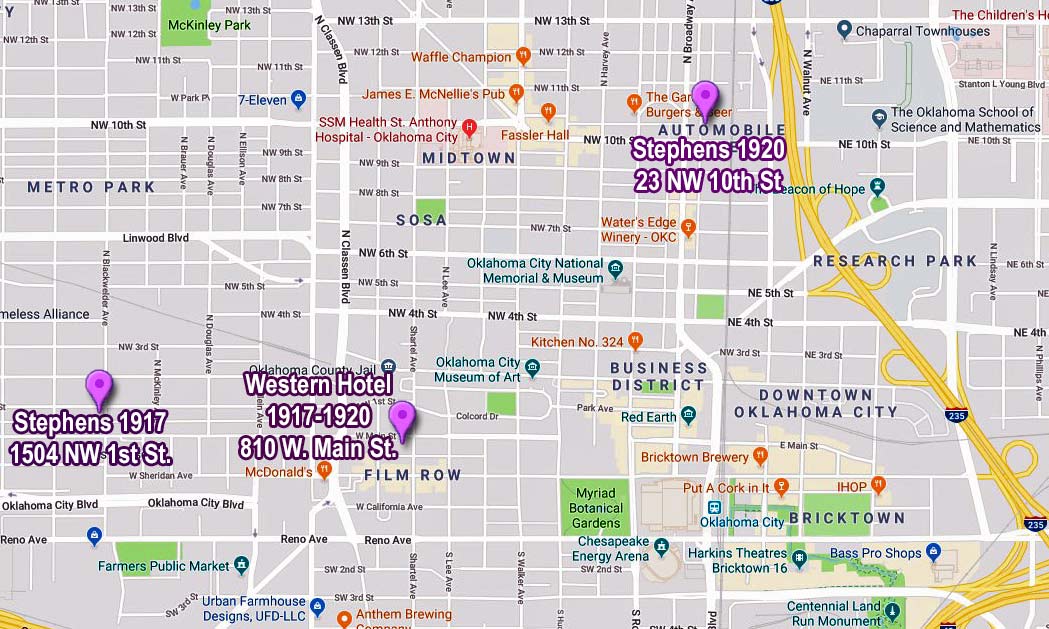
AERIAL VIEW OF DOWNTOWN OKLAHOMA CITY
AND THE LOCATION OF THE WESTERN HOTEL TODAY
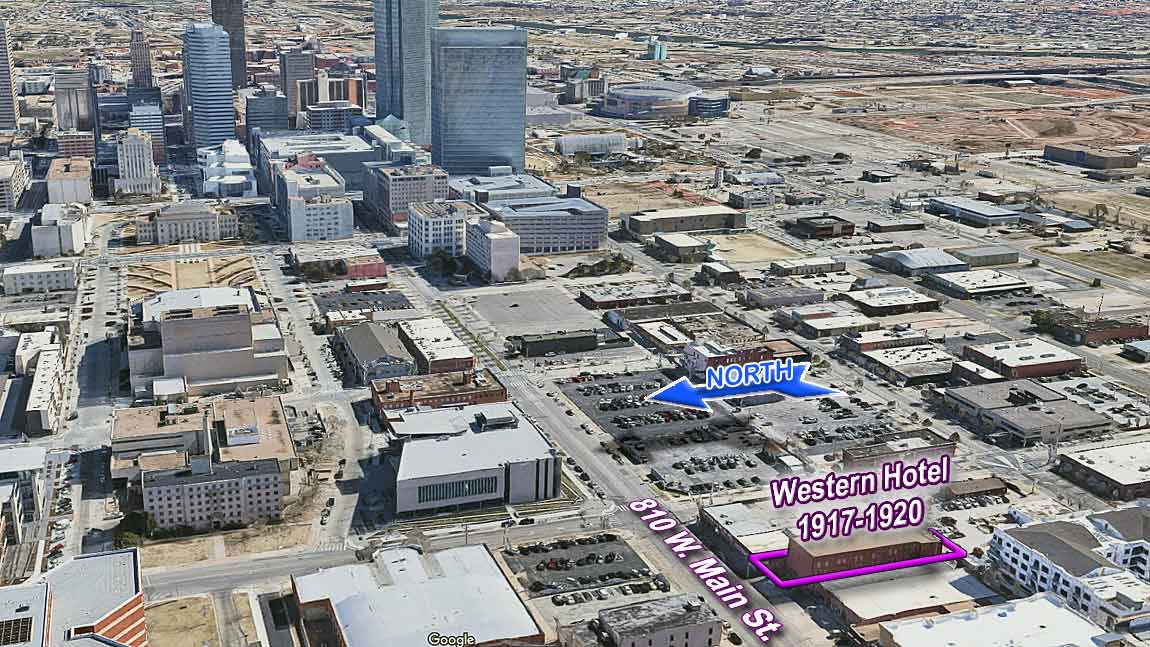
|
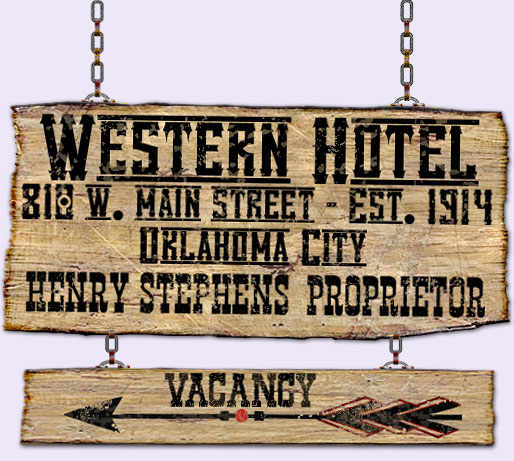
HENRY STEPHENS, FOUNDER OF THE WESTERN
HOTEL ON MAIN STREET, OK. CITY
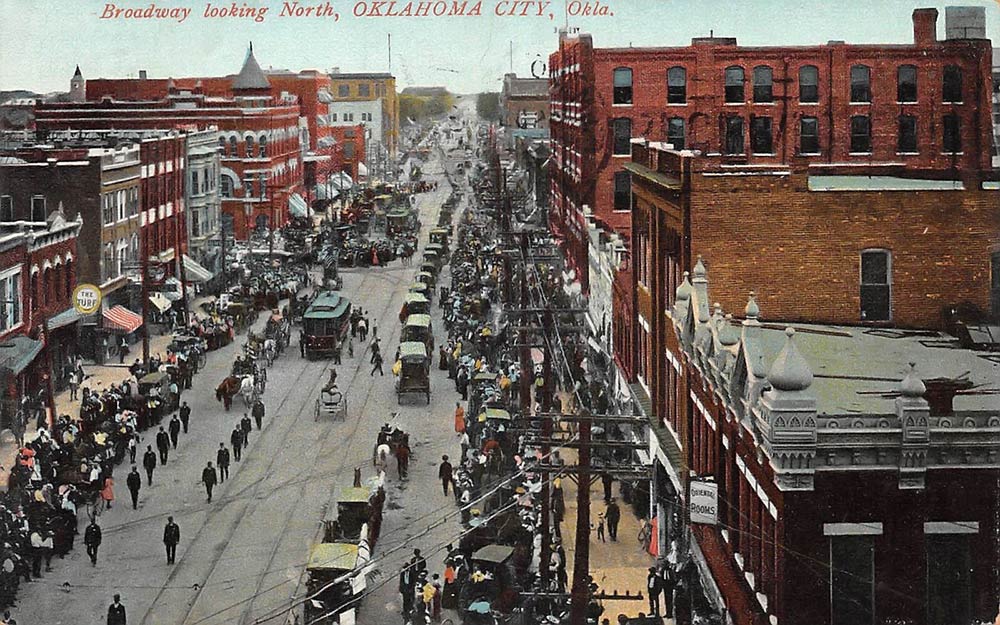
(Not an actual sign.)
At Left: A view of Broadway Ave
looking north in 1907.
Postcard photo from eBay seller.
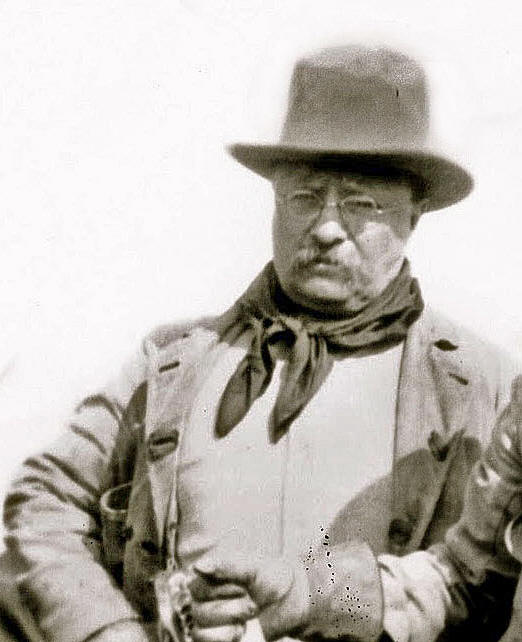
On
April 5, 1905, President Theodore Roosevelt traveled
through Indian Territory on his way to a Rough
Riders reunion in San Antonio, Texas, making short
speeches at several towns along the railroad between
Vinita and Durant. After attending the
reunion, Roosevelt returned to Oklahoma Territory,
arriving in Frederick on aboard a private five-car
train on Saturday, April 8, 1905.
While
giving a speech to the thousands gathered to greet
him, he noticed Comanche Chief Quanah Parker and
called him to the speaker's stand to shake his hand.
Immediately after the speech, the hunting party left
for the Big Pasture, an area of 480,000 acres of
open range in present Tillman, Comanche, and Cotton
counties. When he departed on April 13, 1905,
the President promised to make Oklahoma a state.
That is a promise that he kept more than two years
later on November 16, 1907, when Oklahoma Territory
and Indian Territory were merged into the State of
Oklahoma, becoming the 46th state of the Union.
Oklahoma was the only state admitted to the Union
during Roosevelt’s presidency.
Info
and photo courtesy of
Tillman County Chronicles
HENRY STEPHENS'S SECOND MARRIAGE
Almost
two years after his mysterious departure
from Eaton, Henry turned up in Oklahoma.
Henry
settled in Frederick, Tillman Co, Oklahoma and
there, on Dec. 17, 1908, he married Rena Hinshaw of Tuttle, Grady Co, Oklahoma.
Henry and Rena were both 43, according to their
application for marriage, license and certificate.
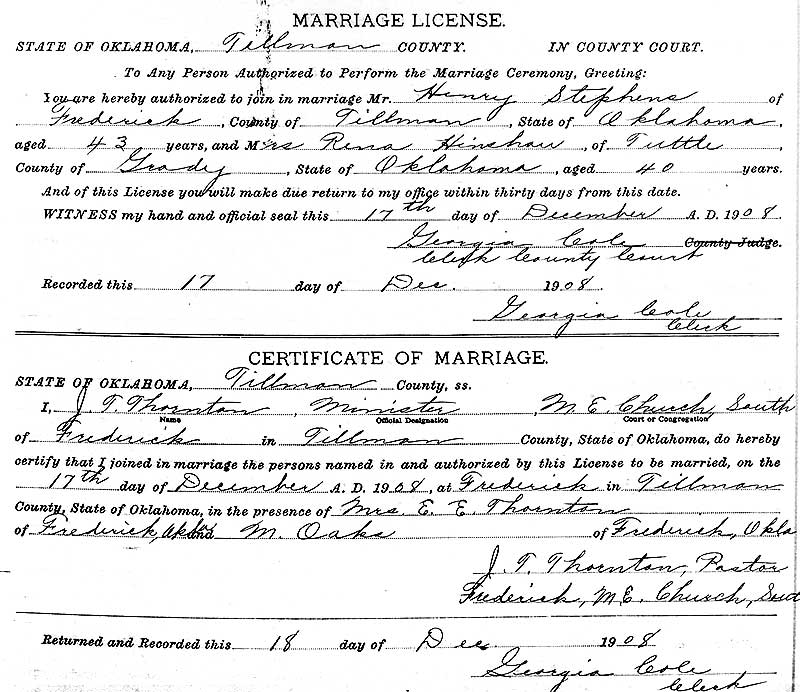
Bird's-eye view of
street and commercial buildings at Oklahoma City,
Oklahoma during the 1910 Glidden Tour. Sign for
Oklahoma Gas and Electric Co. in foreground. Spooner
& Wells, Inc., photographers, Detroit, Mich.
Detroit public library digital collections
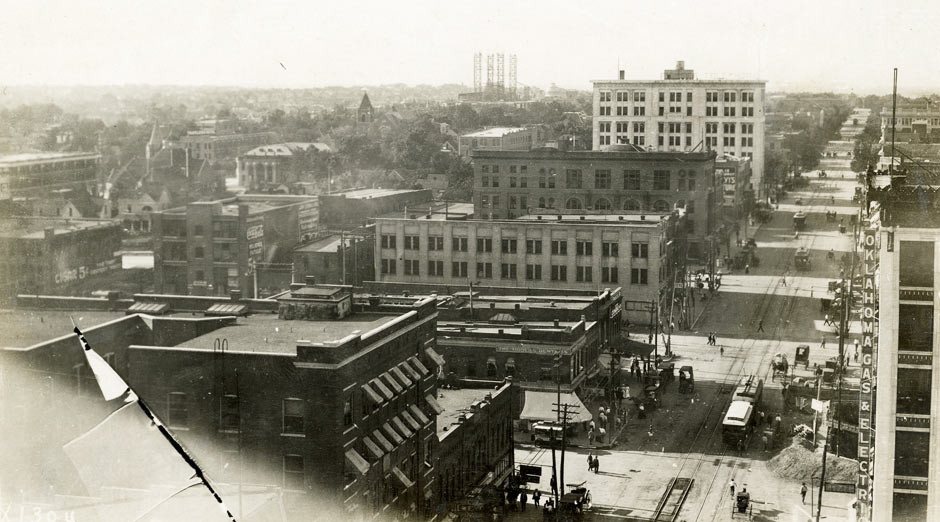
View
of Main Street in Oklahoma City, Oklahoma during the
1910 Glidden Tour. Mellon's department store and the
Kerr Dry Goods Co. in background
Detroit public library digital collections

View of A street in Oklahoma City, Oklahoma during the
1910 Glidden Tour
Detroit public library digital collections
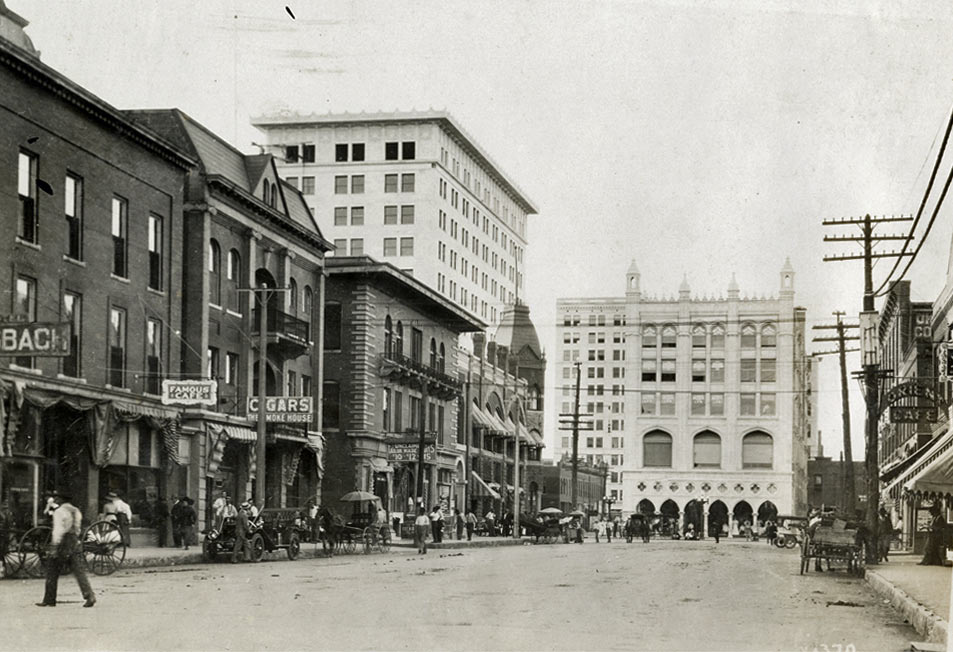
HENRY AND RENA HINSHAW STEPHENS ON THE
1910 CENSUS, OKLAHOMA CITY The record shows that this was a second marriage for both
of them, and they had been married for a year.
Rena was the mother of two children, both living
at the time. One was her son
Virgil Hinshaw from her previous marriage;
Virgil was 15, and her and Henry's
daughter Agatha was 2 months old. Rena was
born in Texas, her parents from Missouri, her
son born in Missouri. |
|
 |
|
On the
1910 Census, Henry and Rena Stephens were living at
their boarding house at 129 W. 2nd St. in Oklahoma City.
|
Henry's occupation
was
proprietor at a boarding house. There
were 22 roomers listed in their
dwelling, so they likely were living at their
boarding house.
|
 |
|
 |
HENRY & RENA STEPHENS START THE WESTERN HOTEL,
1914
In April
1914, Henry and Rena Stephens, along
with William E. Kirby, incorporated as
the Western Hotel company in Oklahoma
City with capital stock of $3,000. Their
hotel was located at 810 Main St.
|
|
|
FORD MOTOR COMPANY CAUSES A STIR
IN OKLAHOMA CITY
In July of 1915, the Ford
Motor Co. planned to build an assembly
plant in Oklahoma City and some
confusion led to the mistaken belief
that Ford had purchased the Western
Hotel on Main St. in order to build
their plant there. To clear up the
matter, an article in the July 9, 1915
DAILY OKLAHOMAN, titled WESTERN HOTEL NOT IN
FORD'S PURCHASE stated:
In published
descriptions of the property
acquired by the Ford Motor company
for its proposed assembling plant in
Oklahoma City, the Western Hotel on
Main street was mentioned when, in reality,
it was not one
of the places included in the
transfer. It is
located one block east of the Ford
site. There was some confusion
concerning the identification by
name of the Ford property and the
Western hotel was erroneously linked
with the deed. That hostelry will continue to
operate as usual, its management
having no intention of retiring from
a satisfactory and profitable
business. The Junction Hotel, one
block west, however, has been taken
over as part of the Ford purchase
and, of course, when building
operations commence will have to be
dismantled.
Patrons of the
Western hotel were somewhat alarmed
over reports that their abiding
place was going out of business
when, as a matter of fact, such is
not the case.
The Oklahoma City Ford
Motor Company Assembly Plant is a
four-story brick structure in downtown
Oklahoma City, Oklahoma. Opened in 1916
by the Ford Motor Company as a Model
T manufacturing facility, it was one of
24 such plants built by Ford between
1910 and 1915.
|
|

Photo courtesy of OKLAHOMAN gallery
early day Oklahoma City collection.
The above
photo was described as
City
streets east from 600 block on Main
before 1920.
However, this couldn't be before
1924 because that's when the 2-story
Ford assembly plant seen at right which
was ADDED on the west end of the
larger 4-story
plant. Also,
this couldn't be Main Street because the
west end of the building is seen on the right, so the
photo was taken looking NORTH.
The only
way to take a photo showing only the
2-story Ford plant on the right looking
straight down the middle of a street
would have been 1924 or later and shoot
from the south looking north before the
street became Classen Bl. when it must
have been a straight street (Olie St..)
 |
|
The Oklahoma City Ford
Motor Company Assembly Plant (Oklahoma
City Plant) is locally significant under
Criterion C for the area of
ARCHITECTURE.
The period of significance is 1916 and
1924, the construction completion dates
for the four-story building and the
two-story addition, respectively.
Info from the National
Park Service - National Register of
Historic Places |
|
 |
THE LARGER PLANT BUILT FIRST
Completed in 1916, the
building is an excellent example of a
manufacturing facility designed
specifically for the assembly of
automobiles through a process pioneered
by the Ford Motor Company (Ford).
In an unprecedented expansion, Ford
constructed twenty-four regional
assembly plants, including the Oklahoma
City Plant, between 1910 and 1915.
|
 |
|

THE SMALLER, 2-STORY BUILDING ADDED
IN 1924

FORD'S FRED JONES
ASSEMBLY PLANT, OKLAHOMA CITY

1916 view
of north face looking southeast from
Main St., FRED JONES ASSEMBLY PLANT,
Ford Motors, Oklahoma City.
PHOTOS COURTESY OF OKLAHOMA HISTORICAL
SOCIETY WEBSITE

1939 view of north face
looking southeast on Main St.
|
|
|
WESTERN HOTEL ADVERTISING
Advertising for
the Western Hotel appears to have begun in March
of 1917 with the first ad located shown below.
Since Ralph Stephens was working there that year,
it may have even been Ralph's idea to advertise.
|
|
Ads for the Western Hotel were basic and
straightforward, often timed with various events
that were taking place in Oklahoma City,
such as conventions or the State Fair |
|
-Western-hotel-ad.jpg) |

Now and then they ran a promotion such as this
one seen at right.
Cut the High Cost of
Living |
|
This ad appeared
FIFTEEN times in the month of Dec. 1918.
It was the only ad run
that month except for the one
on Dec. 24, 1918 shown below it.

 |
This article shows that Henry Stephens was the hotel's
owner. It is a listing of places citizens could
register to vote. The list was grouped by
district, each district listing the different
locations by voting precinct number. The article has
been edited to show the relevant Precinct, 12, where
Henry Stephens's Western Hotel is listed.

|

THE HONEYMOON IS OVER
FOR HENRY AND RENA STEPHENS
It
appears that Henry's
marriage to Rena ended by January 1919,
and
Rena had a long career in marriages
after Henry Stephens. Her maiden name was
Glover, concluded from the surnames of
her surviving brothers.
Rena
Glover Hinshaw Stephens Smith Burdge
Montgomery Cunningham*
*This
marriage information is from
Finda-A-Grave posted by Janet
LaMotte, MHR. It hasn't been
verified, although
everything Ms. LaMotte has shared
concerning Henry appears accurate
(except possibly Henry's middle
name--King.)
The
Oklahoman, Saturday, Feb 24, 1945:
Services for Mrs Rena Cunningham, 77, of
704 NW 3, who died at the LaMont nursing
home Thursday, will be 2 pm Monday at
Garrison Funeral Home.
Born in
Collin County, TX, Mrs Cunningham came
to Oklahoma in 1905. She settled in
Oklahoma City and lived here for 39
years. She was a member of the Nazarene
Church, American Legion Auxiliary Post
35, Rebekah Lodge, and the WCTU.
She is
survived by two sons, W. E. Hinshaw,
1010 NW 22; and V. J. Hinshaw, 628 NW 6;
two brothers, J. H. Glover, Tuttle; and
John Glover, Bentonville, AR; and four
grandsons, all of whom are overseas.
Burial will be in Rose Hill.
|
|
Husband
#1: William Clark Hinshaw 1855-1900
Children:
Ethel M. Hinshaw 1887-
William Elmer Hinshaw 1889-1971 Tuttle, OK
Joel F. Hinshaw 1892-
Virgil J. Hinshaw 1895-1968 Tuttle, OK
Newton M. Hinshaw 1895-
Husband
#2: Henry Stephens 1865-1956
Child: Agatha Stephens 1910-1929
|
Husband
#3: James T. Smith 1855-
Husband
#4: Thomas W. Burdge 1848-1931 marr.
Jun. 13, 1927, Ok. City
Husband
#5: William H. Montgomery 1866-1952
Child: Mary Josephine Montgomery 1904-1972
Husband #6: Samuel T. Cunningham 1863-1942
|
|
|
|
HENRY STEPHENS'S THIRD MARRIAGE - LENA
MULLER
|
|
On Jan.
23, 1919, Henry married a third time,
this time to Lena Muller of Oklahoma
City. Henry was 52, Lena was 40.
 |
|
Henry and Lena (Muller) Stephens were on the
1920 Census, Oklahoma City, 810 W.
Main St, occupation: Hotel Proprietor:

His wife,
Lena, was the hotel housekeeper in 1920.
She was born in Missouri, her parents
were from Germany.
In
this Feb. 13, 1921 ad, Henry Stephens of
the Western Hotel, among others, is listed as having
bought orange groves in Florida.
Clermont, Florida is the home of the Citrus Tower,
which USED TO overlook orange groves as far as
the eye can see.
Condos and apartments have replaced the groves. |

|
This is
the only hotel ad that names
the owner of the Western Hotel. |
The Daily
Oklahoman lists 56 hotels, their
addresses and phone numbers, in their
Sep. 27, 1925 issue. |
|

 |
 |
|
TRAGEDY IN THE STEPHENS FAMILY, SUICIDE
OF AGATHA STEPHENS |
|
 |
 |
May 13,
1929 - Miss Agatha Stephens, 19,
1234 N. Western, died Saturday at Tulsa.
Survivors, her parents, four brothers,
W. E. and Virgil
Henshaw, Oklahoma
City,
Ralph Stephens, Tampa, Fla.,
and Grover Stephens, Dayton, Ohio,
and one sister, Mrs. Nellie
Mayer,
MUIR
Kansas City, Mo. Services
will be conducted from the Hahn funeral
home Monday at 2 p.m. by Rev. J. Frank
Montgomery. (THE OKLAHOMAN)
TampaPix note: Agatha
Stephens was the daughter of Rena
Glover Hinshaw Stephens and Henry
Stephens. She was a half-sister of
William Elmer Hinshaw, James Virgil
Hinshaw, She
was a half-sister of Ralph Stephens,
Grover Stephens and Nellie Stephens
Mayer. [Contributed
by Barbara Linnane Ryan Guest at
Find-A-Grave] |
|
HENRY AND LENA (MULLER) STEPHENS ON THE 1930
CENSUS
Henry and
Lena (Muller) Stephens were living at
their Western Hotel at 810 W. Main
St., where Henry was the Hotel Proprietor.

His wife is Lena, b. in Missouri, her parents from
Germany.
|
|
DEATH OF LENA STEPHENS
 Henry's
3rd wife, Lena Stephens, died a few
months after their 1930 Census was taken.
The article states she owned and operated the hotel for
the past 11 years, which dates it back to 1919,
the year she married Henry. Notice
her age is the same as given on her 1930
census. Henry's
3rd wife, Lena Stephens, died a few
months after their 1930 Census was taken.
The article states she owned and operated the hotel for
the past 11 years, which dates it back to 1919,
the year she married Henry. Notice
her age is the same as given on her 1930
census.
The hotel continued on after the deaths of
Henry's daughter and wife Lena, but there's no
indication as to whether or not Henry still
owned it until 1945.

-Western-hotel-ad.jpg)
|
 |
This
article below is evidence that Henry
Stephens was no longer the owner in
March of 1945, as the sellers here
are Barney & Anna C. Mohr.
 |
|
The
hotel was apparently situated on the
2nd floor with a cafe on the first
floor. |
|
|
It appears
that after the Stevensons bought the hotel
from the Mohrs, they
continued the use of the
building as the Western Hotel at least until
Feb. 20, 1948.

Preliminary
research finds no immediate family connection of
Guy M. Murrah with
Judge Alfred P. Murrah for whom the Murrah
Federal Building in OK City was named. |
|
|

Ralph Stephens
and son Robert were in L.A. because they had opened a Dolores
Restaurant there. |
THE DEATH OF HENRY
STEPHENS IN LOS ANGELES
The Daily Oklahoman,
Sunday, Nov 11, 1956:
Graveside services for Henry Stephens,
Oklahoma City resident 30 years, will be
Monday, 2:30 pm in Rose Hill Cemetery.
Stephens, 91, died this week in Los
Angeles. He had been living in a rest
home there two years. He is survived by
two sons, Ralph A. Stephens., Los
Angeles, and Grover Stephens,
Dayton, OH; a granddaughter, Mrs.
[Dolores] J Phillip Boyle Jr, of 1113
Belford; three grandsons, Vincent R., 5
NW 16th and Robert Stephens, Los
Angeles; and Jerry Muir, living in
Louisiana. Hahn-Cook Funeral Home is in
charge of arrangements.
(Buried next to Lena Stephens
1873-1931.)
|
Wife #1:
Sarah J. Fraley 1866- (Marr. 10 Dec
1884, Christian Co, IL) died aft 1900
Eaton, OH
Children:
Grover H. Stephens 1885-1968
Eaton, OH
Nellie Stephens Muir 1889-1954
bur. Rose Hill Burial Park Ok. City
Ralph Stephens 1892-1983 bur.
Rose Hill Burial Park, Ok. City. |
Wife #2:
Rena Glover Hinshaw 1867-1945, bur.
Rose Hill Burial Park, Ok. City
Child:
Agatha Stephens 1910-1929 bur.
Rose Hill Burial Park, Ok. City
Wife #3 Lena Muller
c.1874 - 1930 bur. Rose Hill Burial
Park, Ok. City. N/C |
|
Contributed by Janet LaMotte, MHR at
Find-A-Grave |
|
Today, the
site of the Western Hotel at 810-812 Main
St. is the home of Dagwell Dixie
Company, an automotive repair shop and
supply retailer.

It might even be the same
building, it appears to be two stories
tall.
|
|
|
| THE
FIRST WESTERN HOTEL IN OKLAHOMA CITY
There was
another Western Hotel before Henry's,
but at a different location. The first
Western Hotel in Oklahoma
City was one found at 216 California
Avenue in the early 1900s. A short, one paragraph
article in the DAILY OKLAHOMAN on Aug
27, 1902 stated:
[The
Western Hotel] ...is quickly becoming one of
the most popular $1.00 a day houses
in the city. The new managers have
gotten things in good runing [sic]
order and are making it quite
pleasant for their guests, which is
attested by the house being full all
the time. If you want a
pleasant room and good board stop at
the Western Hotel, 216 California.
The new managers it mentions were
probably J. H. Emitt and Jud Cogswell,
mentioned in this next article:
On Jan.
20, 1903, the DAILY OKLAHOMAN reported
that..
Policeman J. H. Emitt last evening
assaulted Jud Cogswell at the
Planters Hotel, on the corner of
Robinson St. and Reno Ave. The
encounter resulted over the
unpleasant business relations
between the men as partners in
conducting the Western Hotel on
California Ave.
The next
day, Jan. 21, 1903, this notice appeared in the DAILY
OKLAHOMAN--Cogswell was out:
Notice: All bills due to the Western
Hotel will be paid to J. Emitt only,
as for Cogswell is no longer
connected with the business.
J. EMITT
The hotel
apparently then closed at some point for
around three weeks until a one-sentence
notice was published in the Feb. 11,
1903 DAILY OKLAHOMAN stating:
The Western Hotel has been reopened
to the public by J. M. Emett and is
ready to accommodate the public.
On May 3,
1904, an ad in the DAILY OKLAHOMAN
indicated a change of ownership had
transpired:
WESTERN HOTEL, 216 W. California
announced newly furnished rooms,
excellent board, $1.25 per day.
Mrs. Mauldin, Proprietor, G. A.
Yantis, Manager.
This Oct.
19, 1904 article signaled the end for
the WESTERN HOTEL, but in name only, as
it continued to operate as the Pearson
House.
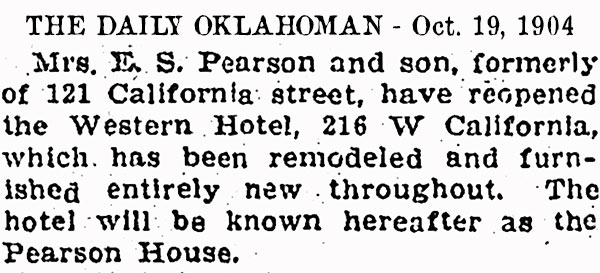
The photo below appeared
in the April 2, 1934 OKLAHOMA NEWS in a
full page feature consisting of several
photos (which were old even in 1934)
submitted to the paper by various
members of pioneer families in the area.
|
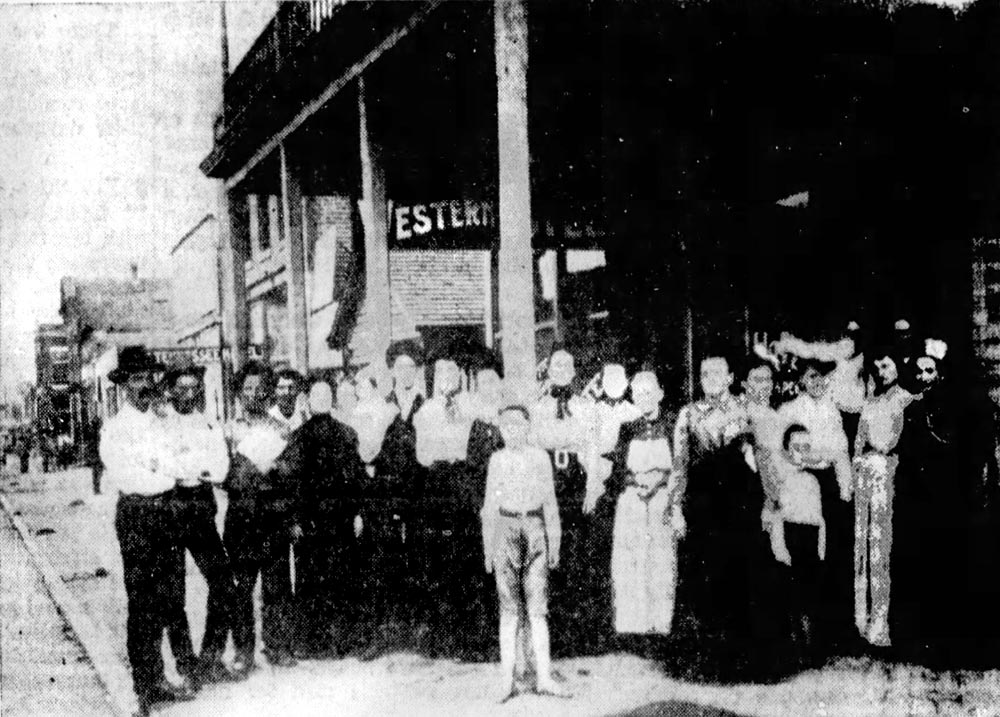 |
| Above is
the old Western Hotel on the
corner of California Avenue
and Broadway. This
picture of employees and
guests was taken about 1900.
Mrs. Lottie Bassett, the
owner, is shown in the front
foreground. (Submitted by
Mrs. Susie Dills, Edmond
Okla.)
TAMPAPIX
NOTE: ABOUT LOTTIE
BASSETT
From Feb. 21,
1903 to Dec. 23, 1903, Lottie and J. E. Bassett are
in involved in a divorce at
which time in Feb., Mr.
Bassett placed public notice
that he was not responsible
for debts incurred by Lottie
Bassett. In late March
Lottie filed suit against J.
E. Bassett for maintenance
and alimony. In early
Dec. 1903 a Notice of Sale
was published in re Lottie
Bassett, Plaintiff, vs. J.
E. Bassett, Defendant.
The writ of execution
provided for $30 per month
alimony, for 6 months, as
well as $25 in attorney
fees, and $16.70 for costs
and interest of $2.90, and
$5 in probable costs.
J. E. Bassett's undivided
property was levied upon,
and it consisted of the
Bassett & Co. Livery and the
Reno Wagon Yard Wood and
Feed. The hotel wasn't
listed as one of his assets.
Since no
mention was made of the
Western Hotel, it was
probably after the divorce
that she acquired it. In 1900,
the block at Broadway and
Main was known as "Bassett
Block." |
ONE MORE WESTERN HOTEL
In the
period from around 1908 to 1913, a hotel
named the "GREAT WESTERN HOTEL" on Nobel
St. is mentioned now and then in
articles relating to persons who have
died or have various other misfortunes
who lived at the hotel mention it but
leave off "GREAT." There were a
few basic ads as well, such as:
GREAT WESTERN HOTEL--Room and board,
$5 per week; steam heat. 318
W. Nobel.
There is
also a GREAT WESTERN HOTEL SUPPLY
company in the area that advertised
profusely in the early 1910s.
|
|
|
RALPH STEPHENS ENTERS THE RESTAURANT BUSINESS
|
|
|
In the Ralph Stephens "timeline of careers" the
last evidences found so far of Ralph working at the
Western Hotel were his 1920 city directory listing
which showed he was the Asst. Manager there, and his
1920 Census, where, he claimed he was the proprietor
of a hotel. The census date was Jan. 1.
WAS RALPH STEPHENS
FIRST CONSIDERING BUYING THE PURITAN CAFE DOWNTOWN?
Ralph's wife Amanda had a brother named Jesse D.
Ogle and her father was Jesse L. Ogle. On Oct. 10, 1920, this
article appeared in the Oklahoma News.

Jesse Ogle was ordered to pay $20 for breaking a
plate glass window at the Puritan Cafe by throwing a
drinking glass through it. If this was Ralph's
father-in--law, why was he in OK City? The
Ogles lived in Hannibal where Jesse L. Ogle was a
carpenter.
If Ralph was having a
cup of coffee or lunch there with him,
this could be an indication
that in 1920 Ralph was first considering buying the
Puritan. There could have been
dozens of reasons for Amanda's father to be there.
Perhaps Ralph asked Jesse to check out the place and
give his opinion,
maybe Jesse didn't think very highly of it, maybe
Ralph asked to borrow money from him, maybe Ralph
and Jesse were just having lunch there and Jesse had
an issue with the food or the service. etc.
Or maybe this was
Amanda's brother, and just a coincidence.
Muny
Judge is slang for
Municipal Judge. |
|
THE CAR BARN CAFE/RESTAURANT
By
early 1921 Ralph Stephens had two sons and a wife to
support so decided to try to
make it in the restaurant business. He opened a place he
could call his own and called it the "Car Barn" because it was
next to the car barn where streetcars were
maintained and stored.
On Mar. 19, 1921,
Ralph ran the first ad for the Car Barn Restaurant at 416 N. Olie Avenue in the Oklahoma News.
This same
Car Barn Restaurant ad ran 20 times in 1921; from March
19 to
Sep. 3, 1921, all in the Oklahoma News, Ok. City. |

The 1921 city directory showed Ralph Stevens was the
proprietor of the Car Barn Cafe. The Stephens
residence "r" was at 1519 W. 2nd. St.
|
|

Maple 4150 is the phone number. |
After Sep. 3, 1921, there were no more mentions of the Car Barn
Restaurant (or Cafe) found in the newspapers Based on lack of later ads, it appears that
Stephens closed it at that time. But maybe
not. |
|
By this time in 1921, Amanda was expecting their third
child in just three months, and with increasing debt, it
could be that Ralph stopped the Car Barn advertising
and sold the place to someone who continued
operating the place at least until March 1922 but
didn't advertise. (See
why this might be in section to follow.) |
|
Ralph and Amanda's
daughter, Dolores, was born in Oklahoma City on Dec. 14, 1921.
Stephens would later name what is described as his "first
successful restaurant" after her. |
Locations of the Western Hotel and the
Stephens residences 1917-1920 (purple) along
with location of the Car Barn restaurant and
the Stephens residence in 1921.

Present day aerial view of the Car
Barn location.
-CAR-BARN.jpg)
KIDNAPPING AT THE CAR BARN
In late
Sept. 1923 an article appeared in the OKC News consisting of an interview
with Ellis R. Merryman who said he was eating at the Car Barn Restaurant
on March 7, 1922 when he was kidnapped at gunpoint by three (or
was it two, Ellis?) Klansmen
impersonating police.
There can be no mistake that the Car Barn was still open.
The question is, did Ralph Stephens still own it or had he moved
on to his next venture?
|
|
The
incident was first reported as a "prank" by "jokers" in the
Mar. 14, 1922 DAILY OKLAHOMAN. Ellis R. Merryman was a
truck driver and a lunch hour waiter at the Car Barn restaurant.
(The date of the article, Mar. 14, 1922 was a Tuesday. It states
that it
happened "Monday night" which would have been Mar. 13 or
previous Monday Mar. 6, 1922. Merryman says it was THREE
men.)

|
An
article also appeared on Sep. 29, 1923 in the OKC paper "The
Record" with a transcript from a military court testimony.*
Here, Merryman says it happened on Mar. 7, which was a Tuesday.
Not a Monday as the article stated. Also, his testimony
was now two unmasked men.

*No explanation has been found as
to why this was held in a Military Court. |
|
In the Dec. 1923 anti-Klan weekly newspaper "Jack Walton's
Paper," kidnapping victim E. R. Merryman's testimony at a
circuit court trial was
printed in an
article titled "Klansmen free on fake alibi." Merryman,
testified how he was cuffed at gunpoint and taken to a place
where he was flogged. He refers to the restaurant as the
Car Barn Cafe. Only another waiter who was witness testified
and is identified
by name, but nothing is printed as to who the owner or manager
was at the time.
|
|
Dec. 23, 1923
issue of the anti-Klan paper "Jack Walton's Paper" |
The headline does not
pertain to this incident. |
|

None of the ads
or articles ever mention who owns the place.
So
either...
|
1. |
Stephens sold the Car Barn in early Sep.
1921 when we see the ads stopped, and the new
owner continued it at least until Mar.
1922, or...
|
|
2. |
Stephens owned the Car Barn at least up until the
time of the March 1922 kidnapping of one of its
lunch hour waiters.
|
|
 |
|
But regardless, Ralph's attempt at his first
restaurant was deemed a failure in an interview with
him which appeared in the Daily Oklahoman on Jan.
21, 1968.
His
debt was beginning to grow.
Could the kidnapping incident have been "the last
straw" for Ralph Stephens and the Car Barn?
Today, the
site of the Car Barn is occupied by an electrical
power substation.
-CAR-BARN.jpg) |
|
RALPH STEPHENS AND
THE PURITAN CAFE
Stephens again tried
his skills in the restaurant business with the Puritan Cafe
at 102 Broadway. As mentioned with the late
Oct. 1920 "Jesse Ogle incident" at the Puritan Cafe,
Ralph could have been considering buying it from the
owners at the time. However, there is no
direct evidence indicating this so far.
The Puritan
was located right in the middle of Oklahoma City,
today it is downtown. Surely Ralph could be a
success in the middle of town during the "Roarin'
20s," right?
Even while Ralph
was still managing the Western Hotel, the Puritan
was cited for health code violations. In Jan.
1919, it was owned by George H. Gurakis and Jim
Christo.

|
 |
A week
after the shutdown, Gurakis & Christo
had the Puritan back
in business. But what did it look
like when Jesse Ogle was there breaking
a plate glass window a year and 9 months
later?
This wasn't the only Puritan Cafe around, there were
many so-named eateries scattered all round Oklahoma
City, in an approximate 50 to 75 mile radius.
Puritan was a very popular name in the
area, not just for cafes and
restaurants. It's doubtful that it was a chain, as there appears
to be no similarity among the various ads, except
for the name. Hundreds
of ads for a Puritan Cafes or restaurants from 1921 through 1923
appeared in newspapers at these other places: Bennington,
Bristow, Coweta, Durant, Eufaula, Haskell,
Holdenville, McAlester, Muskogee,
Okmulgee, Pawhuska, Poteau, Slick, and Wilson, and just
about each one was for a cafe in that town.
But no
ads (except the one to the left) have been found for the Puritan in
OK City until Sept. 9, 1921. |
| |
|
|
|
The
First ad for the Puritan in OKC is this Sep. 9, 1921 ad below. Ralph COULD have
been there if he left the Car Barn about a week
earlier when their ads
stopped on Sep. 3, 1921.
-first-Puritan-Cafe-ad.jpg)
The 2nd ad by the
Puritan in OKC gave their address.
-2nd-Puritan-Cafe-ad-gives-address.jpg)
THE "ALL-AMERICAN"
MOVEMENT
There seems to have
been an obsession with purity and American
citizenship in the area in these years. So
much so, that Bert Yale was concerned that readers
would think he wasn't American due to the omission
of his restaurant in the ad seen on the right, so he had an
explanation printed with the list. He alludes to
this "All American" trend by saying...
"We are the heart and soul of this great movement.."
In the month of Dec.
1921 The Puritan was listed in the series of four ads
(Dec. 5, 16, 20, 24) listing eateries that were
members of the recently formed National Restaurant Association where
"EVERY MEMBER IS AN AMERICAN CITIZEN."
Two restaurants not
relevant at this time have been omitted from the ad
at right, in order to
discuss them later in this feature., but the Car
Barn wasn't listed in these ads.
This "All-American
movement" may be attributed to the beginnings of the
National Restaurant Association, which was formed
over a two year period of events in Kansas City, Mo.
beginning in 1917. The "All American" movement was
probably also fueled by the events in Europe related
to WW1, and by the Association
limiting membership to American men in 1919.
|
THE
FOUNDING HISTORY OF THE NATIONAL
RESTAURANT ASSOC.
From their website at
https://www.restaurant.org/About/Who-We-Are/History. |
|
1917 |
When
egg brokers try to demand a price of 65
cents a dozen, the year-old Kansas
City Restaurant Association, one of
the restaurant industry's earliest
professional associations, organizes an
egg boycott. Egg prices plummet to 32
cents. The seeds of a national movement
are sown. |
|
1919 |
Kansas
City restaurateurs launch a national
organization, holding the first meeting
of what is today's National Restaurant
Association on March 13 in Kansas City.
The fledgling organization represents an
industry of 43,000 restaurants.
[Membership
consisted of
male Americans.] |
|
1920 |
Prohibition begins in 1920, kicking off
a 13-year ban on alcohol sales.
Restaurants used to serving free
sandwiches with 5-cent beers develop new
marketing tactics. Despite Prohibition,
the industry thrives, riding a wave of
national prosperity. Howard Johnson's
opens its first franchises, White
Castle's 5-cent burgers grow popular,
and Willard Marriott opens his first Hot
Shoppes. |
|
1927 |
The
growing National Restaurant Association
moves its headquarters from Kansas City
to Chicago. |
|
1930s |
Prohibition ends, but the Depression is
in full swing. Congress's National
Recovery Act requires each industry to
prepare a "Code of Fair Competition" in
1933. The National Restaurant
Association quickly complies. Membership
doubles. In an appeal to customers in
bleak times, the National Restaurant
Association tries out two advertising
slogan: "Enjoy Life — Eat Out More
Often" and "Take Her Out to Dinner at
Least Once a Week." |
The Puritan ads
take on a distinctive Ralph Stephens style:

The
earliest found direct evidence connecting Stephens with the
Puritan was his 1923 city directory listing and the
article at right about a lawsuit filed against
Stephens and the Puritan. Notice he had a
business partner, E. V. Bodkin. You'll see his
name come up again later in Hannibal, MO, in
connection with Ralph Stephens again.

|


BY
THIS TIME, RALPH PROBABLY OWNED THE PURITAN

Regardless of which
scenario took place with the Car Barn, it was
probable that Stephens was at the Puritan at the
time of this ad.

This ad clearly points
to Ralph Stephens, specifically mentioning their
steaks, "the kind that will make you come back."
That phrase will come back again later in Ralph's
restaurant family.

Nothing further has
been located as to the outcome of this, but if he
lost the suit, it would be one reason he was getting
into a lot of debt. |
|
SO WHEN DID STEPHENS TAKE OWNERSHIP OF THE PURITAN?
In
terms of advertising, there is only a 1-week gap
from the date of the last Car Barn ad (Sep 3, 1921) to
the date of the first Oklahoma City Puritan ad (Sep.
9, 1921.)
1.)
If Stephens sold the
Car Barn around the time the last ad appeared (Sep. 3, 1921)
then he could have gone to the Puritan by Sep. 9,
1921, since the cafe wasn't brand new. In Jan. 1919
it was owned by
George H. Gurakis and Jim
Christo.
2,) If Stephens still owned the Car Barn
through March 1922 when
the kidnapping took place,
then it is unlikely (but not impossible) that he
bought the Puritan
when its ads started in Sep. 1921, six months before
the last known newspaper reference to the Car Barn.
The
most likely situation would be that Stephens sold
the Car Barn around the time the last ad appeared in
early Sept, 1921 and it continued under a different
owner at least until March 1922. If he knew he had a buyer
for the Car Barn, he and Edgar Bodkin could have been negotiating
with Gurakis and Christo to buy the Puritan
immediately after closing the deal with the Car
Barn, and then could have started the advertising for the
Puritan on Sep. 9, 1921.
|
THE OPENING OF STEPHENS RESTAURANT
Regardless of
which scenario took place from the Car Barn to
the Puritan, the ad below shows that by August
of 1923, Ralph and Amanda Stephens were ready to
step up to a higher class level of cleanliness,
quality, food and service. Ralph completely
remolded and refurnished the Puritan and changed
the name to "Stephens."


|
|
|
|
|
|
|
|
|
|
|
|
|
|
|
|
|
|
|
|
|
|
|
-
They will personally supervise
the serving of all meals.
-
 If you aren't treated as an
honored guest, they want to know
it. If you aren't treated as an
honored guest, they want to know
it.
Stephens's want-ad for a chef in the
KC Star on Aug 23,
1923, reveals the restaurant
had a seating capacity for 65. |
Notice in the ad below,
Amanda's delicious pies that would be the
common thread throughout all of their
restaurant ventures.
|
 |
 |
|
It's
difficult to imagine that a place
with ads like this, in the middle of
downtown OK City during Oklahoma
City State Fair week could not
succeed, but according to a 1968
interview in the OKLAHOMAN, this
only drove him deeper into debt
instead of up the ladder of success.
Today, the Puritan/Stephens location would be in the heart of downtown Oklahoma
City's business district.
 |
Locations of all
known places Ralph worked or owned in OK City, as well has
his residences.

|
|
THE
STEPHENS FAMILY MOVES TO DALLAS -
"WE LEFT TOWN OWING EVERYBODY"
Competition and a lot of debt led
30-year-old Ralph Stephens to leave Oklahoma City in
late 1923 with his wife, Amanda, sons Vince and Bob, and daughter
Dolores.
WHY DALLAS ?
In a
Jan. 21, 1968 article in the DAILY
OKLAHOMAN, titled Ride to Top
Bit Bumpy, But Worth It, Ralph
was interviewed by reporter Katherine
Hatch. The article mainly focuses
on Ralph and Amanda's most recent
success with their Dolores Restaurants
in OK City and L.A., but pertaining to his
early endeavors, it says:
|
|
The year was 1923 and Ralph A. Stephens
had just gone broke with his small
restaurant in downtown Oklahoma City.
He packed up his wife and three children
and, as Stephens put it, "left town
owing everybody."
When they left Oklahoma
he took the family to Dallas where they
saw a "Pig Stand with what looked
like a thousand cars around it.."
Pig
Stands... were
the forerunners of our drive-in
restaurants.
|
|
THE DALLAS PIG STANDS
"People with cars are so lazy they don't want to
get out of them to eat." -- Jesse Granville Kirby
Portions below from
Texas Monthly, "The
History of the Pig Stands" - America's motor lunch
by Daniel Vaughn, The American Drive-in" by Michael
Karl Witzel (1992), Car Hops & Curb Service by
Jim Heimann (1996). https://www.hemmings.com/blog/article/jesse-kirby-reuben-jackson/
HEMMINGS CLASSIC CAR Jesse Kirby & Reuben Jackson
FEBRUARY '18 By David Conwill from the February 2018
issue of Hemmings Classic Car
It's
now been nearly 100 years
that a Dallas institution built its
mighty restaurant empire on the
foundation of a simple Tennessee-style
barbecued-pork sandwich called
the “Pig Sandwich.” The
Dallas-based chain that started it in
the early 1920s spread like wildfire to
quickly become a nationwide franchise.
But despite its meteoric expansion and
the cult-like obsession the general
public had with it, the Pig Stand franchise faded out
like quietly
and gradually, like the twinkling stars
at dawn, but dragging out over
decades.
|
THE JESSE G. KIRBY STORY
One of the greatest social changes that
affected restaurants in the 1920s was
the phenomenal growth in the number of
cars and trucks registered by state and
county authorities all over the country.
Dallas County, Texas was no different.
By the 1920s, there were 51, 622 registered vehicles
driving over 1,000 miles of paved,
surfaced or gravel roads crisscrossing
the county.
It was this
infatuation with automobiles that
prompted Dallas candy & tobacco
wholesaler-entrepreneur Jessie G.
Kirby to observe, "People with cars are
so lazy
they don't want to get out of them to
eat."
So he came
up with the idea of a restaurant that
would serve people sitting in their
cars. He believed the time was right.
Kirby had made his reputation selling
candy and tobacco at his mercantile
business on South Akard Street; Jackson
had made his money as a surgeon.
Kirby soon
persuaded prominent local physician Dr.
Reuben Wright Jackson to provide the
initial capital to get the venture
established.
Jackson
didn't know much about the food business
but did understand the appeal of the
automobile. He was duly impressed
with Kirby's practical idea and wasted
no time providing the initial cash
needed to build a prototype pork stand.
The collaboration produced a
So in
Sept. 1921, the American automobile
collided head on with restaurants,
forever changing the nature of dining
along America's roadways. With
$300, Kirby built the first restaurant known in
the U.S. to take orders from cars that
pulled up to the curb. He
named it "Pig Stand" because of its
signature fare was his barbecued
pork sandwich.
The first stand
was a
modest, clapboard-covered box at the
intersection of Chalk Hill Road and the
Dallas-Fort Worth Turnpike (now
Interstate 30) in Dallas’s Oak Cliff
neighborhood, about one-fifth the way to
Fort Worth. This was beyond the
outskirts of the town of Dallas
back then. One by one, drivers
hungry for something new eased off the
throttle to become part of the festive
grand opening.
With streets on two sides of the
building, it was ideal for curb service.
The server would hop up on the running
board of the car, before it even parked,
and take the order, then run to the
kitchen. When he returned with the
food, he again hopped up on the running
board and delivered it. From this
came the term "Car hop" and the
gender-free name stuck, from the first
teenaged boys wearing white hats and
shirts with black bow ties, to the
uniformed glamorous young women who
replaced them at the start of WW2.
A short
time after the first Pig Stand was opened at Oak
Cliff, Kirby built a second stand
in Dallas. It opened near the center of town—Zang
Blvd.
and Bishop, now known as Colorado Blvd.
It followed the same design philosophy
as the first stand--close proximity to the curbside
with car hops serving the arriving cars.
|

Photo from
GONE BUT NOT FORGOTTEN Dallas
Historical Society. Legacies: A History
Journal for Dallas and North Central
Texas, Volume 19, Number 1, Spring,
2007, periodical, 2007;
University of North Texas
Libraries.
By September of 1923 he had sold the
original location and relocated No. 1 to
2nd Avenue in Dallas. (It operated
there until 1932 when the lot was
purchased by the State Fair of Texas.)
Kirby and his business
partner Dr. Reuben Jackson, set sights
on expansion in Dallas—and beyond.
In late
October, 1923, The Pig Stands Company
was incorporated by J. G. Kirby, R. W.
Jackson, and S.T. Lake, for the purpose
of "manufacturing raw meats into edible
and table products."
As president of the company, Dr. Jackson
preferred to be the silent partner,
deferring to Kirby to manage the
enterprise.
 |
| |
"Credit is often
given to Kirby for creating the
first drive-in restaurant. And
rightly so, if for anything, the
fact that the concept of carhops was
first introduced at the original Pig
Stand. There are plenty of other
firsts attributed to them too: the
first onion ring, the first
chicken-fried steak sandwich, Texas
toast, neon lights. Some of those
claims might be hard to prove, but
they all serve as anecdotal evidence
of Kirby and Jackson’s
innovativeness."
|
Pig Stand No. 2,
Circa mid-1920s
At first glance the
stand appears quite large,
but the right side of the
photo is actually a very
large two-billboard
advertisement.
Place your cursor on the
image to show the Pig Stand
isolated.

The above
photo, courtesy of
"Barbecue" by Robert Moss,
shows Pig Stand No. 2 in the
mid 1920s. "Stand No.
2" can be seen on the sign
above the window where the
two car hops are standing.
The same
stand in the photo below and
appears to have been taken
at the same occasion--the
cars are parked in the same
position in both photos.
 |
|
The photos
above and below are courtesy
of
GONE BUT NOT FORGOTTEN
Dallas Historical
Society. Legacies: A History
Journal for Dallas and North
Central Texas, Volume 19,
Number 1, Spring, 2007,
periodical, 2007; University
of North Texas Libraries,
The Portal to Texas History.
[This site
misidentifies this Pig Stand
as No. 1 in Oak Cliff.
It also incorrectly quotes
Kirby as saying "People with
cars are so CRAZY..."] |
|
Pig Stand
No. 2 at Zang & Bishop
Circa mid-1920s

|
This appears to be a rear view of
the stand taken at night from between the stand
and the large billboards seen in the first
photo.
Kirby
and Jackson rarely get credit for it
today, but they may have been the first
to invent the restaurant chain as we
know it. Howard Johnson restaurants are
generally given the credit for
developing the concept, HOWEVER,
...the second Howard
Johnson was a franchise location
when it opened in 1932; by that time
there were already more than a
hundred Pig Stands, and the company
had been offering franchises to
hopeful entrepreneurs since 1925**.
As Kirby once cleverly told someone
of opening a franchise,
Most agree that the year was 1921,
but a few records suggest it may
have been in early 1922. Court
records from a lawsuit against
Dixiepig Stand from 1929 list the
original opening date as April 15,
1922, and an ad celebrating the
achievements of the company
[seen below] that had
“opened less than thirty months ago”
ran in the Dallas Morning News on
October 12, 1924.
[The math:
10/12/1924 - 24 months = 10/12/1922 - 6
months = April 12, 1922. Almost
exact date referred to in the 1929
lawsuit.]
**The
same 1924 ad reveals that the franchisee
opportunity was already in operation.
Read more about the history and
eventual decline of Kirby's Pig Stands at
Texas Monthly, "The
History of the Pig Stands" -- America's motor lunch
by Daniel Vaughn
|
WAS RALPH WORKING FOR KIRBY'S PIG
STANDS?
Ralph Stephens was hired by a Dallas BBQ chain and
learned the operation in Dallas before going out to
open a stand in Little Rock.
Did he
get hired by Kirby's?
By
early Nov. 1923, Kirby had incorporated with two
partners, R. W. Jackson and S. T. Lake. Although it wasn't the only "pig
stand" in Dallas, (there were some "mom & pop" ones
around, and some who were bordering on infringing on
the Pig Stands trademark and copyrights.) The
ads for Kirby's Pig Stands would have spoken
directly to Ralph Stephens's drive for success--they
have "SUCCESS" written all over them. Here was
an eatery already tried and proven successful, and the
inventor was selling not only the food, but the formula
and
instructions as well. The popularity of
Jesse Kirby's Pig Stands spread like wildfire in all
directions.
There
can't be any doubt that Ralph heard of the great
success Kirby was having while he and his family
were in Dallas. Kirby's new
concept--drive up curb service, was something Ralph
would later use at every one of his next three
restaurants. The ads were tempting indeed--learn the process,
use the founder's successful formula, pick a
location, open your own
stand, you make money, he makes money.
|
It
was "Less than thirty months ago" (no earlier than
mid-April of 1922) that Kirby started
his empire, according to this Oct. 12, 1924 ad
below, with one stand on the Dallas-Ft. Worth Pike.
Some parts of this ad
(mostly the very small texts) are digital
recreations of the original which appeared in the
Dallas Morning News on Oct. 12, 1924. The
original ad was spread across the center fold and
was nearly illegible at that area. The text
size of the main column was extremely small compared
to the rest of the ad, so the text has been provided
here larger in relation to the whole ad. Fonts
are an exact match or nearly exact. The
graphics are the originals, cleaned up. The
NuGrape and Edelweiss/Orange Crush ads were not part
of this ad. They were added to fill the space
created by the longer center column. Those are
from a 1925 Pig Stands ad of similar arrangement.
The Pig Stand ads featured different vendors at
different times.
|
|
Dallas Morning News - Oct. 12, 1924
|
|
 |
|


 |
And now Mr. J. G. Kirby, the founder and the active head
of the Pig Stands Company (incorporated under the laws
of Texas) finds his company one of the biggest customers
of the jobbers and wholesalers who operate in this
territory. Pig Stands are operating most
successfully in other States not only of the Southwest
but also of the Southeast and the North. The "sign
of the pig," guiding the public to the places where the
world's most delectable sandwich may be bought, is seen
in Dallas, Fort Worth, Wichita Falls, Waco, El Paso, San
Antonio, Houston, Beaumont, Denver, San Diego, Los
Angeles, Tulsa, Kansas City, Jacksonville, Fla., and New
Orleans. Every week finds calls coming in for Pig
Stand rights to operate in new fields.
Mr. Kirby has followed the soundest of basic business
principles in establishing and operating this concern.
In the first place, he sells a distinctive and highly
meritorious product and has avoided a multiplicity
of side-lines; in other words, he has "stuck to the one
thing." And, having created a demand, he buys
advantageously in large quantities. He holds down
operating and "overhead" expense by specializing in one
thing and by doing business in simple, inexpensive
buildings of standard design. While they are small
and simple in pattern they are by no means unsightly
"shacks" or in any way detrimental to their
neighborhoods.
To
give the reader an idea of how this business has grown,
the ten stands alone are operated by sixty-five employes.
The Pig Sandwiches consumed in Dallas each week use
50,000 Kleber buns (made especially for Pig Sandwiches,
according to specifications).
The customers drink more than 14,4000 bottles of
Coca-Cola products each week (not including other
drinks). With the Pig Sandwiches sold in Dallas
each week there are used 10,000 pounds of the finest U.
S. government inspected meats. Incidentally, this
company has an expert meat buyer who spent six years in
the largest packing plants. All meats used by the
Pig Stands Company in Texas are selected by him.
Pig Stand meats are cooked in Mazola. They use in Dallas 3,640 bottles of Budweiser weekly.
They buy from Dallas jobbers 500,000 to 1,000,000 paper
napkins at a time and between 35,000 and 50,000 paper
bags.
The sour relish, which gives zest to the Pig Sandwich
and which Mr. Kirby concocted himself, is made under his
own specifications and delivered in fifty 5-gallon lots
at a time. When Mr. Kirby first started his
business he made this relish at home in his own kitchen,
but the demand soon made this impractical. The
pickle factory which now has this contract manufactures
the relish under rigid specifications as to purity and
quality.
The Pig Stands Company takes this opportunity to thank
the public for its most generous patronage, and wishes
the readers of this paper to know the concerns of whose
products enter into the world's most delectable
sandwich. They're represented on this page.
The best is none too good for its customers.
|


 |
|


|
| DEATH
OF JESSE G. KIRBY - April 9, 1926
Jesse Kirby didn't
live to see the peak of his Pig
Stand empire, he died at age 39 in
on April 9, 1926 in St. Louis. Jesse was taken ill
while on a train ride on a business
trip and he died in a St. Louis
hospital just a four years after the
start of his Pig Stands. He was
survived by his wife, Shirley, and
their two sons who would both become
restaurateurs.
After Kirby’s death, Shirley
continued operating the Pig
Stand company with Jesse's
partner, R. W. Jackson. Under
their guidance, the brand got so
popular that copycats began to
appear. The company took out an
ad in 1927 ad that read
“Imitation Pig Stands are
springing up like mushrooms all
over Dallas.” They would
unsuccessfully sue one of them,
the Dixiepig Stand, whose
specialty was a “Dixiepig
Sandwich.” (Another Dixie Pig
exists in Abilene, Texas. They
have a “Pig Sandwich” on the
menu, but with roasted pork and
barbecue sauce, it’s not one
that Jesse Kirby would
recognize. It’s missing the
“sour relish which gives zest to
the Pig Sandwich.”)
|
|
 |
 |
|
 |
|
Pig Stand
Locations compiled by Daniel Vaughn |
|
#1A
Dallas, the original opened in 1921 or
1922 on Fort Worth Pike (now Davis) at
Chalk Hill Rd.
#1B
Dallas at 1400 Second Ave. at Trezevant
(demolished to make way for Fair Park
expansion)
#2 Dallas at 1301 N. Zang and Bishop
(now Colorado)
#3 Dallas at 5119 East Grand Ave.
#4 Dallas at 3715 Greenville
#5 Dallas at 3702 Maple Ave.
#7 Houston at Washington and Sawyer
|
#10
Beaumont at Port Arthur Rd. & Highland
#11 Fort
Worth at 643 North Main St. #12 Fort
Worth at 1615 Park Place
#13 Fort
Worth at 2736 W. Seventh (became
Randolph’s Bar-B-Cue in the 80’s, then
Stagecoach BBQ in 1991)
#15 Dallas
at 4605 McKinney & Knox
#15 Dallas
at 736 W. Jefferson
#18 Los
Angeles
#23
Beaumont
#25 Dallas
at Gaston and Grand (air conditioned)
|
#28 Dallas
at 1611 Forest Ave. #29 San Antonio at
1508 Broadway St. (now Mary’s Pig Stand)
#30
Houston at 4803 Main.
#38 Dallas
at 4017 Oak Lawn
#41
Beaumont at 1955 Calder
#42 Dallas
at 1907 S. Buckner
#42 Fort
Worth at 2320 E. Belknap
#49
Beaumont
#50 Dallas
at Abrams and Northwest Hwy. (Last
location in Dallas. Closed 08/25/1985)
#? Dallas
at 1801 S. Ewing
#? Dallas
at 1512 Main
|
|
|
|
After the company lost its
battle in court, other copycats
used the legal precedent to cash
in on the pig stand fever. Among
those were Van’s Pig Stands in
Wewoka, OK (1928); Ju-Cy Pig
Stand in Denton (1932); Bob’s
Pig Shop in Pauls Valley, OK
(1933); Flying Pig Stand in
Denison (1937); and Pearl’s Pig
Stand in Jefferson (1939).
The Pig Stands company couldn’t
fight back with the law, so it
would...stand out, by design. The company
created a signature building and
layout for its restaurants, one
that would be easily
recognizable to motorists. The
Pig Stands Co. hired architect
F. J. Woerner, the man who
designed the Stoneleigh Hotel in
Dallas, to be in charge of the
company’s new branding. The
prototype was built on the site
of Pig Stand #2 before being
rolled out to other cities and
states.

Pig Stand #2 in
Dallas, after1928 reconstruction.
(OR san antonio)
Photo is courtesy of Texas
Monthly, "The
History of the Pig Stands" -- America's motor lunch.
By Daniel Vaughn
Read more about the history of
Kirby's Pig Stand Company during
the Great Depression, the WW2
years into the Baby Boomer
years, and it drawn-out decline
in the 1980s, at this site where
all the text in italics is from,
courtesy of Texas
Monthly, "The
History of the Pig Stands" -- America's motor lunch.,
By Daniel Vaughn.
“Give
a little pig a chance, and it will
make a hog of itself.”
-- J. G. Kirby
|
|
| |
|
THE STEPHENSES IN HANNIBAL, MO. AND THE FIRST GOODY
GOODY
Before
heading to Little Rock, the Stephenses stopped by Amanda's family's home in
Hannibal, Missouri, where his wife and three children would wait
while he went to Little Rock to get the stand
started.
Jan.
21, 1968 article in the DAILY OKLAHOMAN,
Ride to Top Bit Bumpy,
But Worth It
|
|
"That first Sunday in Hannibal, I
was talking to Mrs. Stephens's father, a
carpenter, and I told him we should be
able to figure out some kind of
enterprise on our own, without having to
work for someone else." Stephens
recalled.
LESSONS LEARNED IN DALLAS
If there was anything that Ralph Stephens would have learned
from his experience in Dallas and the success of Kirby's Pig
Stands, it probably would have been the popularity of drive-in
curb service, a place with ample parking, advertising, a limited
menu consisting of one to very few specialties, use of the best
meats, the popularity of the barbecue sandwich, and a
tasty yet unique sauce to top it with. Kirby used a sauce
based on sour pickle relish.
But one thing he surely didn't get
from Kirby's operation was a just plain name. Ralph
Stephens had a better idea--a catchy, unique name.
|
|
THE
FIRST GOODY GOODY BARBECUE, HANNIBAL MISSOURI
DAILY
OKLAHOMAN, Ride to Top Bit Bumpy,
But Worth It
In June, 1925, the "Goody Goody" barbeque
stand opened in Hannibal, owned and operated
by the Stephens family. He had never
gone back to Dallas. "We
slept in the stand while it was being built,
and finally opened for business"
Stephens recalled. |
Ralph may
have bought a Pig Stands franchise, but the reporter
wrote "He had never gone back to Dallas." As if
Ralph made a reference to originally going only to set
up the stand in Little Rock, and perhaps would then go back to Dallas to
continue working there for the company. It could
be that his job was to oversee
stands in various towns around that part of the country.
Either way,
it is clear he would be working for an employer, due to
his conversation with his father-in-law about starting
an "...enterprise of our own, without having to
work for someone else" which is what a Pig Stand
would have been.
Also, his
decision to go with BARBECUE could only have come from
his exposure to it in Dallas; none of his prior
restaurants mention barbecue.
No doubt his father-in-law, a carpenter, would have
played a major role in designing and building the stand.
Notice the similarity of the "Goody Goody BARBECUE" sign
to the Pig Stand signs, and although made of wood
instead of brick, the similar design of the stand itself
to accommodate curb service.

 |
Goody
Goody Barbeque, Hannibal, Missouri
Photo courtesy of
RetroMetro Oklahoma City
Stephens opened his barbecue
stand at 2629 St. Mary's Avenue in Hannibal,
Missouri and named it Goody-Goody Barbecue. Their residence
was at 2520 Chestnut.
Evidently his
idea to start his own restaurant in Hannibal came soon
enough to make it into the 1925 city directory. It
doesn't name the restaurant; it's possible that he hadn't yet thought of a
name by the time the information for the 1925 directory was gathered.
But it is more likely that the early Oklahoma City directories only
provided the owner's occupation and did not provide the name of the
business, as others were listed this way as well.
|
|
| Around the
time Ralph and his family left Dallas or had
settled in Hannibal, the first Pig Stand
opened in Oklahoma City. March, 1925. |
 |
Goody Goody
Barbeque at 2629 St. Mary's Ave., Hannibal, Missouri
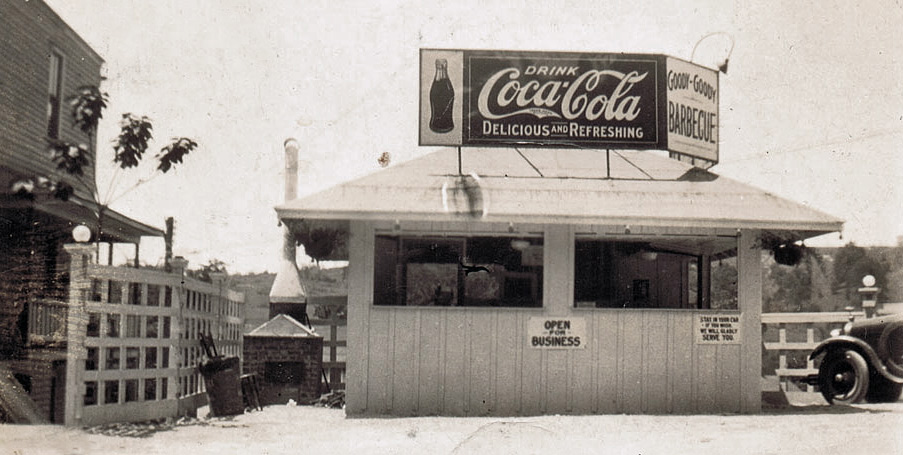
Notice the brick barbecue on the left and the
lattice fence and landscape in the background
indicating that the property dropped off behind the
stand.
Photo
from
RetroMetro Oklahoma City
RALPH IS
LURED TO FLORIDA, GIVES UP ON HIS HANNIBAL GOODY GOODY
Clearly, the catchy name and the Pig Stands
ingredients for success weren't enough.
Ralph didn't figure on the cold weather so far north.
In Dallas, it wasn't a major factor, but in Hannibal,
Missouri, cold weather isn't the best condition to be
eating outside in one's car.
Business
boomed immediately, but cold weather brought
a sharp drop in the drive-in business,
Stephens recalled.
"We
closed, and being sort of soldiers of
fortune, we took off for Florida.
Florida
was in the midst of a land boom in the early 1920s; rich
investors were heading there in droves to buy up land.
The state would be booming with travelers, and surely
the weather in sunny Florida would be a paradise for
drive-in dining with curb service. But in 1925,
the land boom had peaked.
|
Today, the site of
Ralph's first Goody Goody is the parking lot for Smith's Funeral
home.
The building was where you see the SUV parked in front of
the property railing. The property drops down several feet
behind the railing.

This rear view below from Hawkins
Ave. shows the retaining wall that was behind the Goody Goody
stand.

Aerial views
Place your cursor on the image to see in 3D view.

|
THE SECRET WEAPON --
IT'S THE SAUCE!
The most important
event mentioned
thus far in the history of Ralph's first Goody Goody, other than
the actual opening of it, is that while in Hannibal, Amanda
Stephens had picked up a recipe for a unique sauce from a
barbeque stand in nearby Quincy, Ill.
That sauce
(and Amanda's pies) would be
the common thread for ALL the Goody Goodys EVERYWHERE, to this
day.
Later, the Stephenses would call it their "COME BACK
SAUCE" because it kept customers coming back for more.
|
 |
|
|
OH GOODY GOODY?
ABOUT THAT CATCHY NAME |
|
The topic of how Ralph
Stephens came to call his barbecue stand "GOODY GOODY" is
scarce on the Web. Long ago when TampaPix was
researching this topic, there was a comment or two
at most on blogs or web pages, probably the Oklahoma
Historical Society page on Ralph Stephens, or the
OKC RetroMetro site, which were comments to their
"Ralph Stephens story" on his success with the
Dolores Restaurant.
At least one
mentioned that they believed it was inspired by
Ralph and Amanda's daughter, Dolores. Perhaps
an exclamation such as "Oh, goody goody!" or even
that she suggested it. But this is only
speculation. The only public statements about the
Hannibal Goody Goody made by Stephens appear in the 1968 article in the DAILY OKLAHOMAN. Amanda would
have been 3 years old to turn 4 in Dec. 1925.
|
|
|
ENTER: HARRY EARL GRIGSBY
Harry E.
Grigsby was born in Miltonvale, Cloud
Co, Kansas
in 1890, the third child of four
of Charles A. and Mary
Grigsby, natives of Iowa and Indiana.
Harry was 10 years old in 1900, so he was about
the same age as Ralph Stephens, who was
2 years younger. At this time, Harry's
father was a bowling alley operator. |
1900 Census, Clay
Center, Kansas
 |
|
HARRY STARTS OFF ON THE WRONG FOOT IN
OK CITY
Oklahoma had just achieved statehood in
1907 when Harry came to Oklahoma
city to seek his fortune that same year.
Or maybe for another reason.
|
|
 |
AT LEFT:
Harry was all set to marry Lillie Motz (or Metz or Matz) and was in the process
of doing so while under arrest at the
county jail, when word came from the
county attorney's office and stopped* the
ceremony. Harry was there because
the city was in the process of considering prosecuting Harry
on a "statutory charge."
*BELOW:
The article is misleading, incomplete at
best. Apparently, the marriage had already
taken place and
may be why there seems to have been no
"statutory charge" pursued.
The bride's name on their marriage license is Nellie Motz
and she married Harry on Dec. 11, 1908,
the day before the article was published.
Nellie's guardian Jennie Keith gave the
underage permission, and Harry's father,
C. A. Grigsby, gave permission for
Harry. Harry & Nellie were 17
(or 18) &
16, respectively. Harry's birth
year bounces around at 1890 or 1891 on
various records.
On Jan. 17, 1909, their
son Harry Orval Grigsby was born in
Oklahoma City. |
| |
|
|
 |
BELOW: Six months later they were back in court,
this time because Harry was seeking a
divorce on the grounds of desertion.
Looks like Lillie took off
with little Harry O.

Hopefully,
Harry was
eventually granted the divorce
because on May 23, 1910, 18
yr. old Lillie Grigsby
married 22 yr. old Charlie
Hill in OK City.
Little Harry
O. would have been around 16
mos. old.
Ten years later, in 1920,
Charlie Hill and wife Lillie, and her
11 yr. old son Harry O. Grigsby,
were living in Kosoma, OK.
Lillie was from Arkansas, her father was from France and her
mother from Illinois.
Later, Lillie moved
out west with her son. She married
a third time--to Mr. E. L. Ballard.
Harry O. grew up and lived in San Diego for a time
in 1930 with his first wife Sadie, and worked as a
chauffeur in the construction business.
This may have led to his ultimate
career--plumber. Their son Robert O. Grigsby was born
around 1931 in California. |
By 1935, Lillie and Harry
E's son Harry O. had moved
to Salinas in Monterrey Co,
CA, and then to
Chelan, Washington where he
lived in 1940 with his next
wife Edna F, a native of
Oklahoma. Harry O. was
a house plumber.
Around 1945 he moved to San
Bernardino, CA, He died
there in 1961 at the age of
52. He was survived by
his widow, possibly his 3rd
wife, Mae, his mother
Lillian Ballard, his stepfather E.
L. Ballard, his son Robert
O. Grigsby, and four grandchildren.
Harry O. was a WW2 veteran
of the U.S. Navy. |
|

By now there
are probably many
descendants of Harry Earl
Grigsby. |
 |
MEANWHILE, "BACK AT THE RANCH"
1910 Census of Harry E. Grigsby, 615 S.
Walker, Oklahoma City
By 1910, the whole Grigsby family
had moved to Oklahoma City from Kansas,
except Thurza, Harry's oldest sister.
She had married a Mr. Wilkins by this
time.
This census shows Harry's father had become an
ice cream peddler. His sons,
William and Harry, also sold ice cream
on the streets,
and his daughter Docia, worked as a cook
in a cone factory. Here 20 yr. old
Harry
was listed as single.

|
|
 |
HARRY
GRIGSBY REMARRIES
Harry married Jennie
Humphreys on Mar. 29, 1913 in
Oklahoma City. They were both 22 at the
time. This time no parental
consent was needed. |
|

|
|
HARRY HAS A "ROW"
WITH A POOL HALL
OWNER |
|
The
OKLAHOMA NEWS reported on Jan. 24,
1916, that Harry had a bit of a row*
with cigar dealer/pool hall owner C. W. Sims on the
previous Monday, Jan. 17. Sims
rented the first floor of a building
for his pool hall, and he sub-rented
a corner of it for Grigsby to run a
short order stand.
Harry
and Sims had been having trouble over their
lease and when Sims showed up there
he found Harry had partitioned off
his stand from Sims's pool hall, so
he started to tear down the
partition.
Harry threw a big chain at him and
Sims went after him with his cane.
At least, this is what they told the
police when they showed up.
Harry was charged with burglary
and assault, because Sims said Harry
broke a padlock in the building so
he could connect to the gas mains,
which Sims had cut off the existing
supply when their dispute stated
last week.
Harry charged Sims with assault
and destruction of property.
|
 |
|
*Not a term used very often these
days. As a noun - a quarrel,
fight, or disturbance marked by very
noisy, disorderly, and often violent
behavior: affray, brawl, broil,
donnybrook, fray, free-for-all,
melee, riot, ruction, tumult. |
|
HARRY OPENS A SHORT ORDER STAND AT THE CALIFORNIA
AVE. MARKET
Harry had
been in the food service business since
around 1913 (longer, if you count his
job selling ice cream with his father), setting up his short-order
stands in various places. In 1915,
this particular lunch stand, was to be
his third, and it was to be located in
the OK City "California Market House,"
so named because it was on California
Avenue, right in the middle of town on
the first block west of Broadway.
The Market House was like we would consider a flea
market with various booths to rent; a
farmer's market. |
 |
|
Put your mouse pointer on the ad to
unscramble it

Looks like
Harry's menu had become somewhat famous
by this time.
|
|
The
Oklahoma Free Pointer was a 4-page paper
apparently given out for free. It
consisted mostly of classified ads but
did carry one or two pages of stories.
Unfortunately, not many are online and
the issues are a year or more apart.
Looks like Harry may have been
advertising only in this paper in his
early years so there is no record of
where No. 1 and No. 2 were located
in1915. However, No. 1 or No.2
may have been his rental space at 5
North Broadway in the pool hall.
In 1915,
Ralph Stephens was either still in KC
working as a presser in a dye shop, or
working at his father's Western Hotel in
OK City,
or somewhere in between. |
|

A
month later, Harry went back home to
visit with old friends. |
WW1
DRAFT REGISTRATION
On
Jun. 5, 1917, Harry registered for
the WW1 draft. His hometown of Miltonvale, Kansas,
is a short distance west of Clay
Center. Harry and Jennie were
living at 418 Reno
in OK City, a location they would
maintain for many years..
Harry
was still self-employed in the restaurant
business, his Goody Goody lunch
stand, and listed two places, 5
N. Bwdy and 119 W. California.
The former was a failed attempt to
write "Bdwy"-- 5 N. Broadway, the
location of his short order stand in
the Sims pool hall.
Throughout Harry's ads, his
numbering and locations of his Goody Goodys would
change. But his California
Ave. stand was his longest-lived.
|
| |
|
THE OKLAHOMA STATE
FAIR

|
Prior
to statehood, in January 1907, Jones
and Colcord led in the organization
of a state fair association. The
organization located a new
fairgrounds on the city's east side
and held the first State Fair of
Oklahoma in early October, a month
before official statehood day
(November 16). Agriculture remained
at the forefront, with prizes
offered for crop and livestock
competition, as well as several
farming and ranching exhibits. Horse
racing served as the biggest draw,
and the grandstand at the half-mile
track accommodated fifteen thousand
fans for the Oklahoma Derby.
The city of Muskogee also hosted
yearly state fairs, but theirs had
free admission.
|
|
 |
Harry
ran this ad a few times in this time
period, the first one was on Sep. 3,
1919. "THE INVENTOR OF THOSE
FAMOUS CHILI SANDWICHES."
No. 1
was his location he opened in the
California Ave. Market Place in 1915.
No.
2 was in Enid, OK which is about 75
miles NNW of OKC.
No.
3 was at the State Fair Grounds,
which back then was on the east side
outskirts of the city.
During
this period Ralph Stephens was
working at his father's Western
Hotel on Main St. |
|
HARRY & JENNIE GRIGSBY IN 1920
---OK-CITY-restaurant-keeper.gif) On
their 1920 census, Harry and Jennie
were still living at 418 W. Reno.
Harry was listed as a
Restaurant keeper and an employer.
In their home was his 25 year old
cook, Mr. Stanton. On
their 1920 census, Harry and Jennie
were still living at 418 W. Reno.
Harry was listed as a
Restaurant keeper and an employer.
In their home was his 25 year old
cook, Mr. Stanton. |
|
While Harry was living at 418 Reno,
he was renting out a home in the
Capitol Hill district. Harry
was also into investing in Real
Estate. This
area was about two miles north of the
center of town.

Right: From
this ad in June, 1922, we see Harry
was renting out the west side of his
Goody Goody Lunch stand at 111 W.
California Ave
By this time Ralph Stephens was
owner of
the Puritan just a couple of blocks
away, and
was remodeling to reopen soon
as "Stephens" Restaurant." |
A little later, he got a building
permit to build a store on the same
street. No other mention of a
store he owned has been found.
Maybe another Goody Goody.

-Ad-for-rent,-west-side-of-bldg,-GG-owner-H.E.gif) |
|
THE
ONE AND ORIGINAL GOODY GOODY CHILI
SANDWICH!
Harry
went all out with this ad, even
going so far as to apply for a
copyright, patent and trademark.
But unless a food is unique in its make up, it can't be
patented. |
"HERE y' are boys! The one
and original Chili Sandwich!
Patented, copyrighted, and what not,
yet none the less palatable. Harry E. Grigsby is the inventor of
this condensed way of handling the
Mexican national fruit.
By a special process invented by
Grigsby, the Mexican jumping bean
and the piping hot |

Clip art not an actual rendering
used by Grigsby. |
peppers are taught to dwell in
peace and harmony between the top
and bottom sides of a bun. The sandwich filling has all the
advantages of other fillings,
maintains the real qualities of
chili and doesn't run like
mayonnaise dressing.
The sandwiches have become so
well known that Grigsby has applied
for copyright, patents and trade
mark on his product. The
government has granted the
copyright, but the patents and
trademark still are pending."
So here y' are boys, a piping hot
chili sandwich. |
 The
process could be patented, and the
names of both the process and the
sandwich could
be trademarked, but only if each
were unique.
(Think "Big Mac.") Harry did obtain a copyright, which
can be issued for images, photos, and
works of art. So the copyright
he brags about here is for the
picture or artwork image of the
sandwich. The
process could be patented, and the
names of both the process and the
sandwich could
be trademarked, but only if each
were unique.
(Think "Big Mac.") Harry did obtain a copyright, which
can be issued for images, photos, and
works of art. So the copyright
he brags about here is for the
picture or artwork image of the
sandwich.
At
right: A report of U.S.
Copyrights for 1923 at Google books
shows Harry obtained the copyright
on Nov. 12, 1923.
RALPH STEPHENS
Ralph
would have been competing with the
popularity of Grigsby's Goody Goodys
for at least three years now.
It was around this time that Ralph
Stephens gave up on his Stephens
Restaurant and left Oklahoma City
for a new occupation in Dallas. |
|
HARRY "GOODY GOODY"
GRIGSBY - THE LONG ARM OF CALIFORNIA
AVENUE LAW
In
Feb. 1928, Harry made an arrest on a
car theft/kidnapping suspect.
The arrest took place on California
Ave. so it was probably right around
his Goody Goody. No. 1.
|
There is
no record found of Harry
being a law enforcement
officer, however, it
appears that he had some degree of
authorization to act as
one, perhaps what we
would call a
"neighborhood crime
watch" who would
patrol the area
periodically. Harry seemed to have a
bit more authority.
Research of the term
"scout car" in Oklahoma
City newspapers finds
that as automobiles
became more available in
the 1920s, a scout car
officer was an actual
police officer who
patrolled an area in an
automobile instead of on
foot.

|
 |
Harry
seems to
have had some
sort of
position
with the
local law
enforcement
agency as a
"Scout Car
Officer."
Harry would
have been
around 46 at
the time of
this second
incident. |
| |
|
|
Eight years later,
another incident took
place. In late 1936 "Scout Car Officer
H. E. Grigsby" was
arresting a 35 year old
man for drunkenness when
punches were exchanged.
Again, it took place
on California Ave., this
time on the 100 block,
the same block where
Goody Goody No. 1 was
located.
 |
|
|
|
|
1930 Census of Harry & Jennie
Grigsby

Harry
was still a restaurant proprietor. Living with
them were 3 other relatives, all
working at a restaurant, probably
Harry's Goody Goodys. Harry's sister-in-law
Lilly Braun was a waitress, his
nephew John Wilkins was a cook, and
John's wife Bessie was also a waitress.
He
and Jennie were now living
at 809 E. 18th St. (This was a
little over a mile north of where
Ralph's Car Barn cafe was located.)
They probably had made this move
because Harry was having a hotel
built on his 418 Reno property.
HARRY'S CRUSADE AGAINST GRAFT &
CORRUPTION |
|


In
June 1932, Harry decided to run as a
Democratic candidate for county
commissioner of the 3rd district.
He would have been around 41 or 42
years old at the time. At his
rally that day, he was going to
speak on "Extravagance of County
Government."
 By
June 17, the press had
picked up on Harry's Goody Goody,
using it as his parenthetical middle
name. By
June 17, the press had
picked up on Harry's Goody Goody,
using it as his parenthetical middle
name.
|
On
June 24, 1932, Harry received endorsements in the Capitol Hill
News. This paper was around 8
pages and reported news in the area
of the State Capitol building in
Oklahoma City. It, like
Washington D.C's., was built on a
hill. |
|
 |
|
 According to the article above,
Harry
established the Goody Goody Cafe on W. California
Avenue in 1918. It actually
started as a lunch stand in 1915. In
1928, he was responsible for
organizing a
great celebration ceremony when new
street lighting was installed on
California Ave. Brightly lit
streets were referred to back then
as "Great White Ways." He also
gave away $2,500 worth of
merchandise (just who's remains to
be determined.) According to the article above,
Harry
established the Goody Goody Cafe on W. California
Avenue in 1918. It actually
started as a lunch stand in 1915. In
1928, he was responsible for
organizing a
great celebration ceremony when new
street lighting was installed on
California Ave. Brightly lit
streets were referred to back then
as "Great White Ways." He also
gave away $2,500 worth of
merchandise (just who's remains to
be determined.)
Harry
had
also built a hotel on the property
where he had been living at 418 Reno, and was
living now at his "Grigsby Hotel."
Harry went into great detail
with naming specific city officials and
examples of their graft & corruption. If you
wish to see the whole article,
click here.
In the end, Harry didn't do every well in the
election, he came in 2nd to last place.
|
|
|
|

THE NEWLY-OPENED "GREAT WHITE WAY"
WAS
PROMOTED DURING THE 1928 OKLAHOMA STATE FAIR
This
promotion for the new White Way ran
during the State Fair four years
earlier in 1928.
The ad is damaged exactly where it
says how long ago it opened,
"installed several.... ago."
(weeks?)
Regardless, no grand celebration of
the California Ave. White Way or
mention of this opening as Amos
Wilson wrote could be
found in any of 1928 newspapers.
The
White Way was apparently similar to
our Franklin St. Pedestrian Mall
with emphasis on shopping and ease
of access, but
the California Ave. White Way did
allow vehicles. It had no
street car tracks or traffic signals
and they had rid the area of the
"hucksters."
|
MRS. HARRY (JENNIE) GRIGSBY-
HANDY WITH A SHOTGUN
Jennie Grigsby was in the news
more often than Harry. She
was an expert markswoman,
sharpshooter and champion traps
shooter. There were always
shooting competition results in
the news, and for each
tournament Jennie's name was at
or near the top
or near of the results.
Here are a few examples.
(Notice that by 1937, Harry and
Jennie were known as "hotel and
night club owners.")
|
|

|
HARRY FIGHTS CITY
HALL
Though he lost the
election for county
commissioner, Harry
continued to play a
leading role in
standing up for the
rights of business
owners when in
August, 1933, Harry
protested the city's
proposed tax on
beer. Oklahoma
had been a "dry"
state from the day
it achieved
statehood, but it
did allow beer sales
of 3.2% alcohol beer
for consumption at
point of sale and
for take home.
The Federal
Government as well
as the state, in
licensing sellers,
was already
collecting heavy
taxes. Harry
challenged the
legality of the
city's additional
taxation of
requiring a city
license and received a
temporary
restraining order
until a local judge
could rule on it.
|
|

At right:
Harry was backed
by the Oklahoma
Beer Dealers'
Association.
The proposed
City ordinance
assessed a tax
of $15 per year
for dealers
selling for
consumption on
their premises
and $10 per year
for others.
Below: The
City's brief in
defense of the
tax was to be
filed the next
day, Sep. 7,
1933
|
 |
|
 |
|
Clearly, Harry
was counting on
winning this
one, as seen by
his WANTED ad of
Dec. 10, 1933
|
 |
|
Seven months
later, Judge
Hooker had heard
both sides of
the argument and
took the matter
under advisement
(think about it,
possibly do
additional
research and
render a ruling
or decision
later.)
Meanwhile, the
city councilmen
were already
plotting their
next move--to
forbid the sale
of beer where
the public is
allowed to to
dance.
More than one
councilman
favored this
plan or a
similar one "in
order to combat
the growing evil
of beer gardens
where
drunkenness and
disorderly
conduct are
persistently
reported."
Then there were
some who doubted
that would be
legal because
"beer is
adjudged legal
and
non-intoxicating."

VICTORY FOR
GRIGSBY AND THE
BEER GARDENS OF
OKLAHOMA CITY
This article has
been edited due
to it's length.
See the whole
article here.
Click it when it
opens to see it
full size.

|
|
HARRY'S NEXT CRUSADE - COT HOUSES |
|
|
|
|

On Nov. 7,
1937, in an OKLAHOMA NEWS
article titled "FIRMS TO ASK
COT HOUSE BAN
-
California St. Owners Say
Establishments Harmful to Business"
it was reported that businessmen and
property owners on the 100 block of
W. California Ave. announced they
would petition the City Council to
exclude cot houses from the retail
district.
The
article reported that H. E. Grigsby
"who operates a cafe on the block"
and a pool hall owner (J. C.
Thompson) claimed they had
signatures of 100% of the merchants
from the block on a petition.
"They sit out in the front and sun
themselves, some of them only half
clothed." |
 |
 |
Nov. 8 - The City Manager promised
to look into the 10-cent "Flop
houses" after Grigsby presented him
with a petition signed by all the
business owners on the block except
those of the cot houses.
Grigsby said that the situation was
serious and another one was being
built. "A woman can't walk down the
street and a man hardly dares to."
The city manager said they would
look into it to see if the cot
houses constituted a nuisance. |
Nov. 9 - A war of words resulted
before the city council between the
attorney representing the cot house
owners and the attorney representing
the businesses, resulting in a
stalemate and the decision being set
over until the next week.
Attorney Miskovsky said the flop
joints were a menace to health,
safety and morals of the district.
Attorney Showalter for the cot house
owners shot back that one of
protestors operates a beer parlor
and others operate domino parlors in
the vicinity. Then
Councilman Moore responded with "Are
they afraid the cot houses will
corrupt the morals of the beer
joints? Miskovsky "replied
sharply" that the health and morals
of everyone in the area was
endangered. The matter was
then put off for the City Manager
and Health dept. to decide the
following Tuesday. |
Nov.
24, 1937 CITY COUNCIL KILLS
THE ORDINANCE, 7- 0
Residents of the cot houses were
presented to City Council both as
"bums and panhandlers" by the
business owners attorney and "good
men down on their luck" was well as
"clean and sober" by the cot house
owners attorney.
Ultimately, it came down to the cot
house dwellers's
appearance and a report by the city
attorney on exactly whose morals
were being corrupted. He said
that he reviewed police records and
found that "many ladies of leisure
have been taken from the business
houses on the 100 block of
California Ave, and not a one had
been taken from the cot houses."
These places are necessities.
 By
1939, Harry's Goody Goody on
California Ave. was a lunch room
and cabaret, with a floor show and dancing; it
was more like a night club than a
cafe. He
also owned the Grigsby Hotel he had
built where he had been
living all these years at 418 Reno. By
1939, Harry's Goody Goody on
California Ave. was a lunch room
and cabaret, with a floor show and dancing; it
was more like a night club than a
cafe. He
also owned the Grigsby Hotel he had
built where he had been
living all these years at 418 Reno. |
 |
|
|
1940 Census of Harry & Jennie
Grigsby

There were 35 other lodgers
living at Harry's hotel at this
time at 418 Reno. No
occupation was listed for Harry,
he was probably retired by now.
His divorced sister Docia May
Price was living with them.
While the lodgers had an "R" for
renting, Harry had an "O" for
owning the place. His
property was valued at $10,000
while everyone else was valued
under $20.
|
 |
HARRY REGISTERS FOR
THE WW2 DRAFT IN
1942
This was a category
of draft
registration for men
born between April
28, 1877 to Feb. 16,
1897. These
would be men who
were age 45 to 65 at
that time.
Harry was 52.
This time Harry
indicated he was
born in 1890.
His WW1 draft
registration showed
1891.
Harry indicated here
for his occupation
"None - retired."
|
| |
|
|
DEATH OF HARRY
EARL GRIGSBY |
 |
Harry died at
his home on May
18, 1949 at the
age of 59; he
had been
suffering with
ill health for
three years,
which is
how long he had
been retired
according the
article.
He had operated
his Goody Goody
lunch room at
111 W.
California Ave.
up until his
retirement.
He was described
as an
enthusiastic
sportsman, a
member of the
Capital City gun
club, a Mason
and a life
member of the
Knights of
Pythias.
He was a past
patron of the
Fidelis Chapter
of the Eastern
Star Lodge and a
member of the
Methodist
church.
Harry was
survived by his
wife Jennie, and
sisters Docia
Price of OK City
and Thurza
Wilkins of Clay
Center, Kansas.
No mention was
made of his son
Harry Orval
Grigsby from his
prior marriage
to Lillie Metz.
Perhaps this was
not publicly
known or even
something Jennie
was aware of. |
|
|
|
WAS RALPH STEPHENS AWARE OF HARRY'S
GOODY GOODY SUCCESS?
Now
recall the previously discussed
National Restaurant Assoc. "All
American" ads of 1921. Every
one of them showed Grigsby's Goody
Goody locations first. Down at
the bottom was found the Puritan.
It was around Sept. 1921 to March
1922 that Ralph Stephens gave up on
his Car Barn and went to the
Puritan.
If Stephens ever took
a street car ride from the Western
Hotel when he worked there into
downtown, he passed Grigsby's Goody
Goody at 420 W. Main every time.
Downtown, at the Market Place, he
would have seen Goody Goody on the
100 block of California--which was
at the intersection of Broadway, ONE
block south of the Puritan.
Surely Ralph knew of the success
Grigsby was having with his "famous
chili sandwich." He
probably had eaten a few in his
years at OK City. |
|
-ALL-AMERICAN--RESTAURANTS-GOODY-GOODY--replaced.jpg) |
 |
 |
|
Price was Grigsby's
brother-in-law. His sister was
Docia Price. |
|
|
HARRY
GRIGSBY'S GOODY GOODY AND
GRIGSBY HOTEL LOCATIONS

The 100 through 300 blocks of
California Ave. today are
replaced by the Myriad Botanical
Gardens and the Cox Convention
Center. |
|
Harry's Goody Goody stand
at 5 N Broadway was almost across the street
from the Puritan lunch room location.
Ralph Stephens
was intent on being a successful restaurateur,
and seeing Grigsby's success at it, he must have had
it on his mind when he got to Hannibal. |
|
|
 Old
Days
Old
Days







































-Western-hotel-ad.jpg)














 Henry's
3rd wife, Lena Stephens, died a few
months after their 1930 Census was taken.
The article states she owned and operated the hotel for
the past 11 years, which dates it back to 1919,
the year she married Henry. Notice
her age is the same as given on her 1930
census.
Henry's
3rd wife, Lena Stephens, died a few
months after their 1930 Census was taken.
The article states she owned and operated the hotel for
the past 11 years, which dates it back to 1919,
the year she married Henry. Notice
her age is the same as given on her 1930
census.
-Western-hotel-ad.jpg)











-CAR-BARN.jpg)




-CAR-BARN.jpg)


-first-Puritan-Cafe-ad.jpg)
-2nd-Puritan-Cafe-ad-gives-address.jpg)









 If you aren't treated as an
honored guest, they want to know
it.
If you aren't treated as an
honored guest, they want to know
it.













































---OK-CITY-restaurant-keeper.gif)


-Ad-for-rent,-west-side-of-bldg,-GG-owner-H.E.gif)











 According to the article above,
Harry
established the Goody Goody Cafe on W. California
Avenue in 1918. It actually
started as a lunch stand in 1915. In
1928, he was responsible for
organizing a
great celebration ceremony when new
street lighting was installed on
California Ave. Brightly lit
streets were referred to back then
as "Great White Ways." He also
gave away $2,500 worth of
merchandise (just who's remains to
be determined.)
According to the article above,
Harry
established the Goody Goody Cafe on W. California
Avenue in 1918. It actually
started as a lunch stand in 1915. In
1928, he was responsible for
organizing a
great celebration ceremony when new
street lighting was installed on
California Ave. Brightly lit
streets were referred to back then
as "Great White Ways." He also
gave away $2,500 worth of
merchandise (just who's remains to
be determined.) 










 By
1939, Harry's Goody Goody on
California Ave. was a lunch room
and cabaret, with a floor show and dancing; it
was more like a night club than a
cafe. He
also owned the Grigsby Hotel he had
built where he had been
living all these years at 418 Reno.
By
1939, Harry's Goody Goody on
California Ave. was a lunch room
and cabaret, with a floor show and dancing; it
was more like a night club than a
cafe. He
also owned the Grigsby Hotel he had
built where he had been
living all these years at 418 Reno.



-ALL-AMERICAN--RESTAURANTS-GOODY-GOODY--replaced.jpg)



 Ralph A. Stephens began
the drive-in as "Goody Goody Barbecue" when he was 32 or 33 years old,
along with 35-year-old partner Wm. L. Reid, in late 1925. City
directories show it was originally at 1603 Grand Central Avenue, between
S. Dakota and Rome Ave., but closer to S. Dakota on the north side of the
street. It operated there for a few years, then moved to the corner at
1629 Grand Central.
Ralph A. Stephens began
the drive-in as "Goody Goody Barbecue" when he was 32 or 33 years old,
along with 35-year-old partner Wm. L. Reid, in late 1925. City
directories show it was originally at 1603 Grand Central Avenue, between
S. Dakota and Rome Ave., but closer to S. Dakota on the north side of the
street. It operated there for a few years, then moved to the corner at
1629 Grand Central. *The
first ads Stephens placed in the Tribune were help wanted ads.
*The
first ads Stephens placed in the Tribune were help wanted ads.















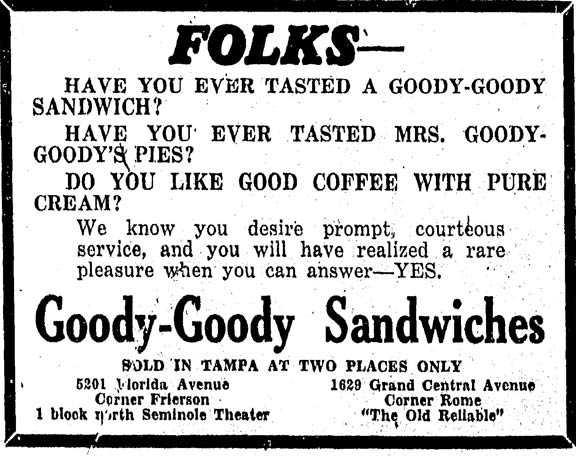




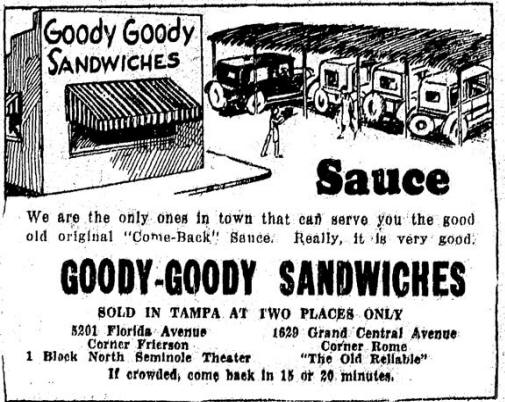















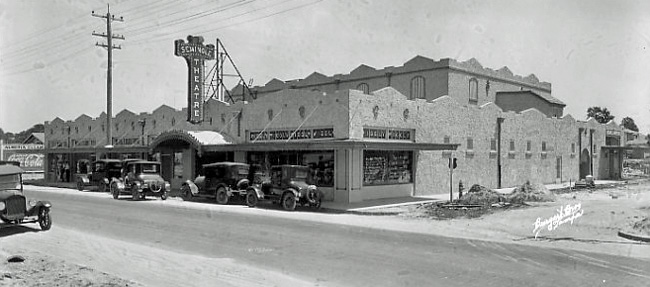




 Around 1927,
William sold his partnership in Carl Vander Voort Company and
decided to make a new start in Florida. At age 45, the
Pittsburgh story was over. His second marriage having failed,
he bought a grove and moved with his children to Winter Haven,
Florida. He stayed there for a few months and then
moved to Lakeland where he bought a 50-acre grove.
Around 1927,
William sold his partnership in Carl Vander Voort Company and
decided to make a new start in Florida. At age 45, the
Pittsburgh story was over. His second marriage having failed,
he bought a grove and moved with his children to Winter Haven,
Florida. He stayed there for a few months and then
moved to Lakeland where he bought a 50-acre grove.








 The
new downtown Goody Goody
The
new downtown Goody Goody

















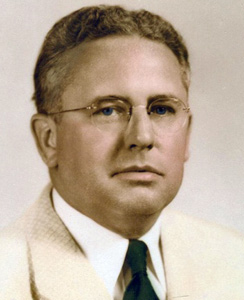
 Sep
17, 1933 ad* "Draft beer is at last GOOD," a reference to the end of
Prohibition
Sep
17, 1933 ad* "Draft beer is at last GOOD," a reference to the end of
Prohibition









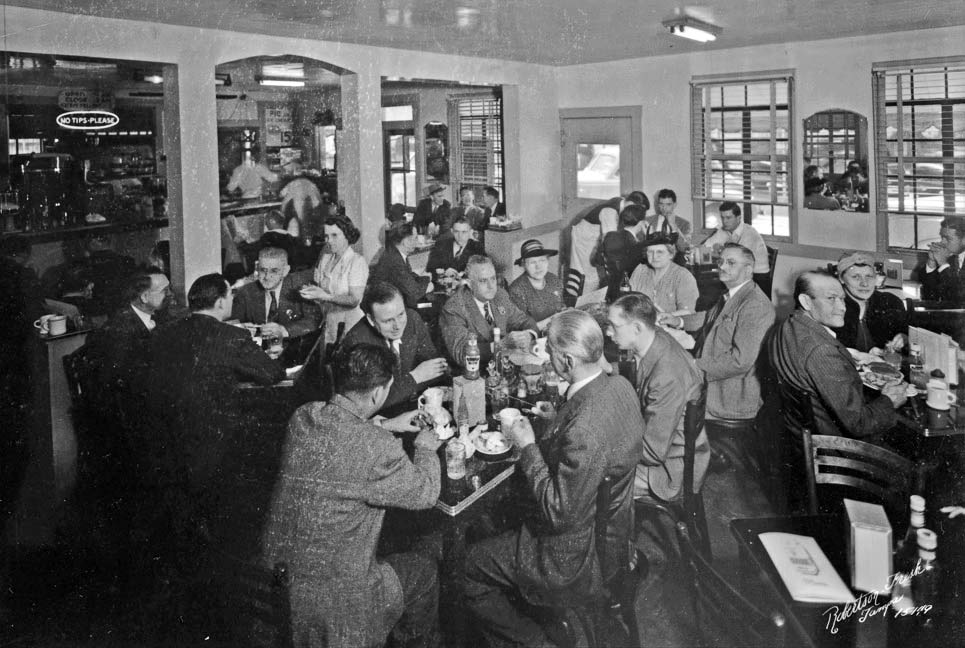















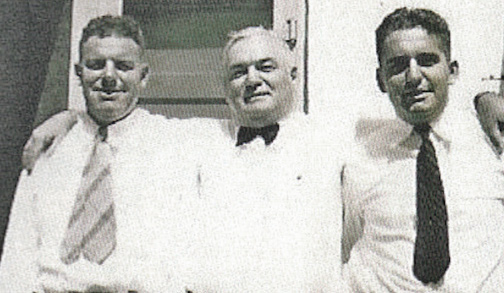
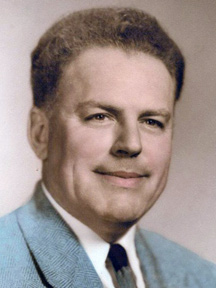



 our produce, the Garcia
Brothers,
our produce, the Garcia
Brothers,
 Victor and Gonzalo for our insurance, Joe Gagliardo at the
Florida Dairy, Poncho Gonzalez at Sealtest , Jose and Manuel Campoamor
and Rudy Ginex for Seafood. Above all, we enjoyed the Spanish Restaurants.
At the Spanish Park, as we came in from the parking area, Gus would seem
to be walking away from us but when he came to greet us and take our order
at the table , he already had our Martinis. Joe Valdes, the owner and his
wife, along with Gus were our personal friends. Also, the Las Novedades
and Cafe Seville on Howard Street."
Victor and Gonzalo for our insurance, Joe Gagliardo at the
Florida Dairy, Poncho Gonzalez at Sealtest , Jose and Manuel Campoamor
and Rudy Ginex for Seafood. Above all, we enjoyed the Spanish Restaurants.
At the Spanish Park, as we came in from the parking area, Gus would seem
to be walking away from us but when he came to greet us and take our order
at the table , he already had our Martinis. Joe Valdes, the owner and his
wife, along with Gus were our personal friends. Also, the Las Novedades
and Cafe Seville on Howard Street."


 William Mote, former Goody
Goody manager, recalls that there were big signs posted when he came to work in
1941: "No Tips, Please." The carhops were still young men,
and the going salary was 20 cents per hour.
William Mote, former Goody
Goody manager, recalls that there were big signs posted when he came to work in
1941: "No Tips, Please." The carhops were still young men,
and the going salary was 20 cents per hour. 

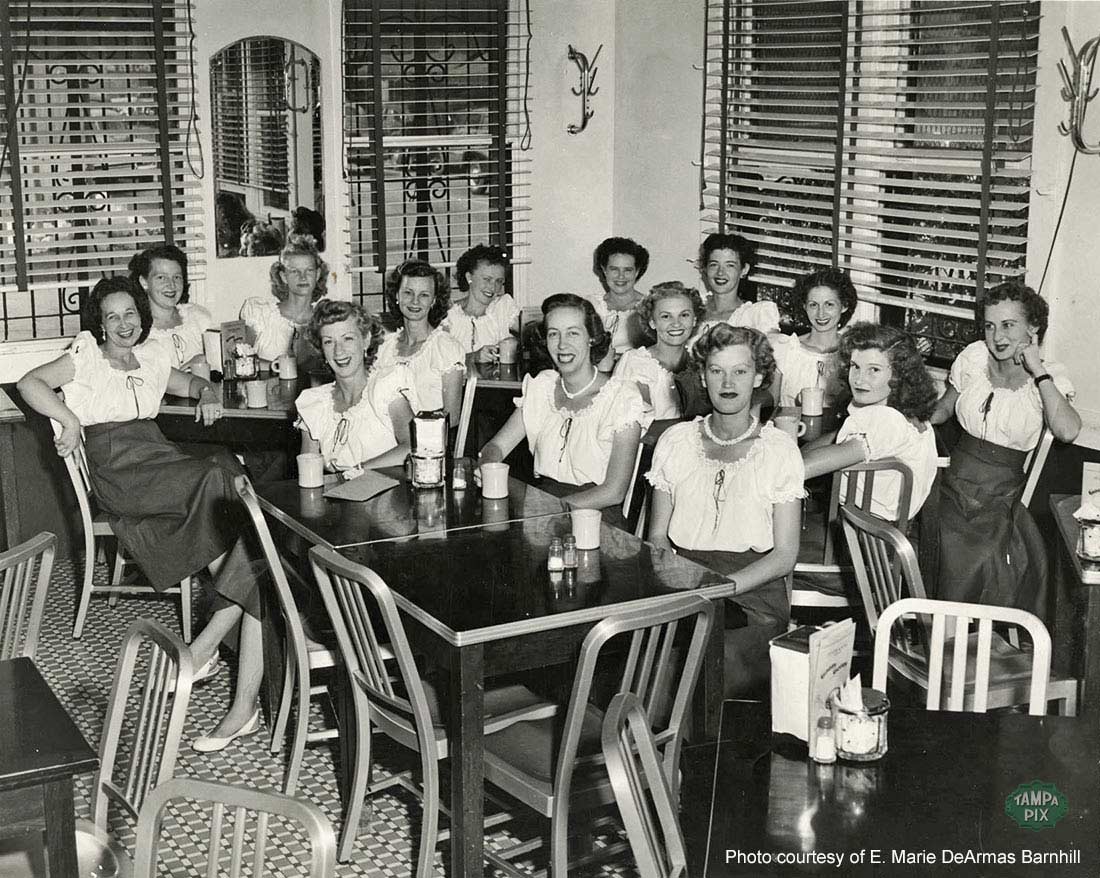



 About
the aluminum chairs
About
the aluminum chairs













 "Our
small ads attracted attention with reverse appeals such as, We have
sold no Cuban sandwiches out of respect for Tampa’s Spanish restaurants.
We combined humor with a small advertising budget and came up with
business gains." When a man left his cane in the dining room, Carl
had a headline: Man comes in with cane and goes out without it. Must
have found new strength with our hamburgers.
"Our
small ads attracted attention with reverse appeals such as, We have
sold no Cuban sandwiches out of respect for Tampa’s Spanish restaurants.
We combined humor with a small advertising budget and came up with
business gains." When a man left his cane in the dining room, Carl
had a headline: Man comes in with cane and goes out without it. Must
have found new strength with our hamburgers.

























